Yogga
Custom modules and extensions
Attention Some modules may not be included into your template package. This section describes configuration of all modules that are used in our templates. Each template pack is provided with a set of modules which is included into the design of this specific template.
JX Accelerated Mobile Page
AMP is an open source library that provides a straightforward way to create web pages.
The module allows improving the functionality of PrestaShop online store on mobile devices and increasing the loading speed of the web pages. It provides the opportunity to create web pages that are compelling, smooth, and load near momentary for users.
Installation and Deleting
The module can be installed and deleted like any other PrestaShop module.
SSL/HTTPS sites are preferable for Google, giving them better indexing and position in search results.
Module configuration
After the module has been successfully installed, you'll see the 'Configure' page that includes 7 tabs with the module settings.

AMP Pages Settings
You can easily create the AMP pages of the store homepage, category page, product page and others. The module will display the limited data of the pages and automatically affects the loading speed of these pages on mobile.

- Use "Full page" button - get back to the original view of the page.
- Homepage - enable/disable AMP for the Homepage.
- Category pages - enable/disable AMP for the Category Listing Page.
- Manufacturer pages - enable/disable AMP for the Manufacturer Page.
- Supplier pages - enable/disable AMP for Supplier Page.
- Product Info - enable/disable AMP for Product Info Pages.
- New products - enable/disable AMP for new products section on the Homepage.
- Bestseller products - enable/disable AMP for bestseller products section on the Homepage.
- Special products - enable/disable AMP for special products section on the Homepage.
- Search products - enable/disable AMP for the search by products on the Homepage.
Homepage settings
You can organize the content of the AMP Homepage according to your preferences using the available settings below.
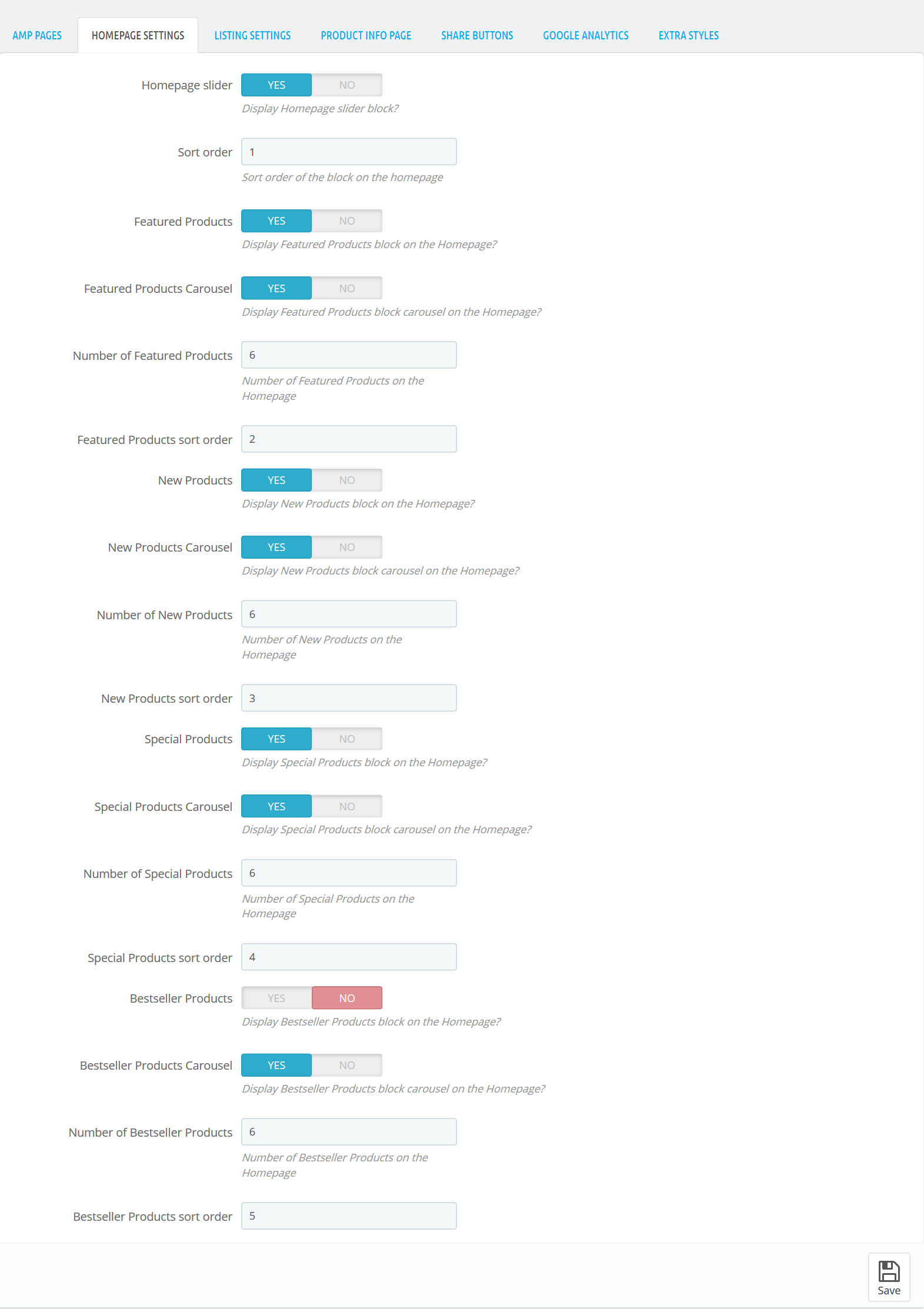
- Homepage slider - show/hide slider block on the Homepage.
- Sort order - set in what order the slider block will be displayed.
- Featured Products - show/hide the featured products block on the homepage.
- Featured Products Carousel - choose whether to display featured products block carousel on the Homepage.
- Number of Featured Products -set the number of featured products to be displayed on the Homepage.
- Featured Products sort order - set in what order the featured products block will be displayed.
- New Products - show/hide the new products block on the Homepage.
- New Products Carousel - choose whether to display the new products block carousel on the Homepage.
- Number of New Products - set the number of new products to be displayed on the Homepage.
- New Products sort order - set in what order the new products block will be displayed.
- Special Products - show/hide special products block on the Homepage.
- Special Products Carousel - choose whether to display special products block carousel on the Homepage.
- Number of Special Products - set the number of special products to be displayed on the Homepage.
- Special Products sort order - set in what order the special products block will be displayed on the Homepage.
- Bestseller Products - show/hide bestseller products block on the Homepage.
- Bestseller Products Carousel - choose whether to display bestseller products block carousel on the Homepage.
- Number of Bestseller Products - set the amount of the bestseller products that will be displayed on the Homepage.
- Bestseller Products sort order - set in what order the bestseller products block will be displayed on the Homepage.
Listing Settings
Organize the additional AMP listing settings.
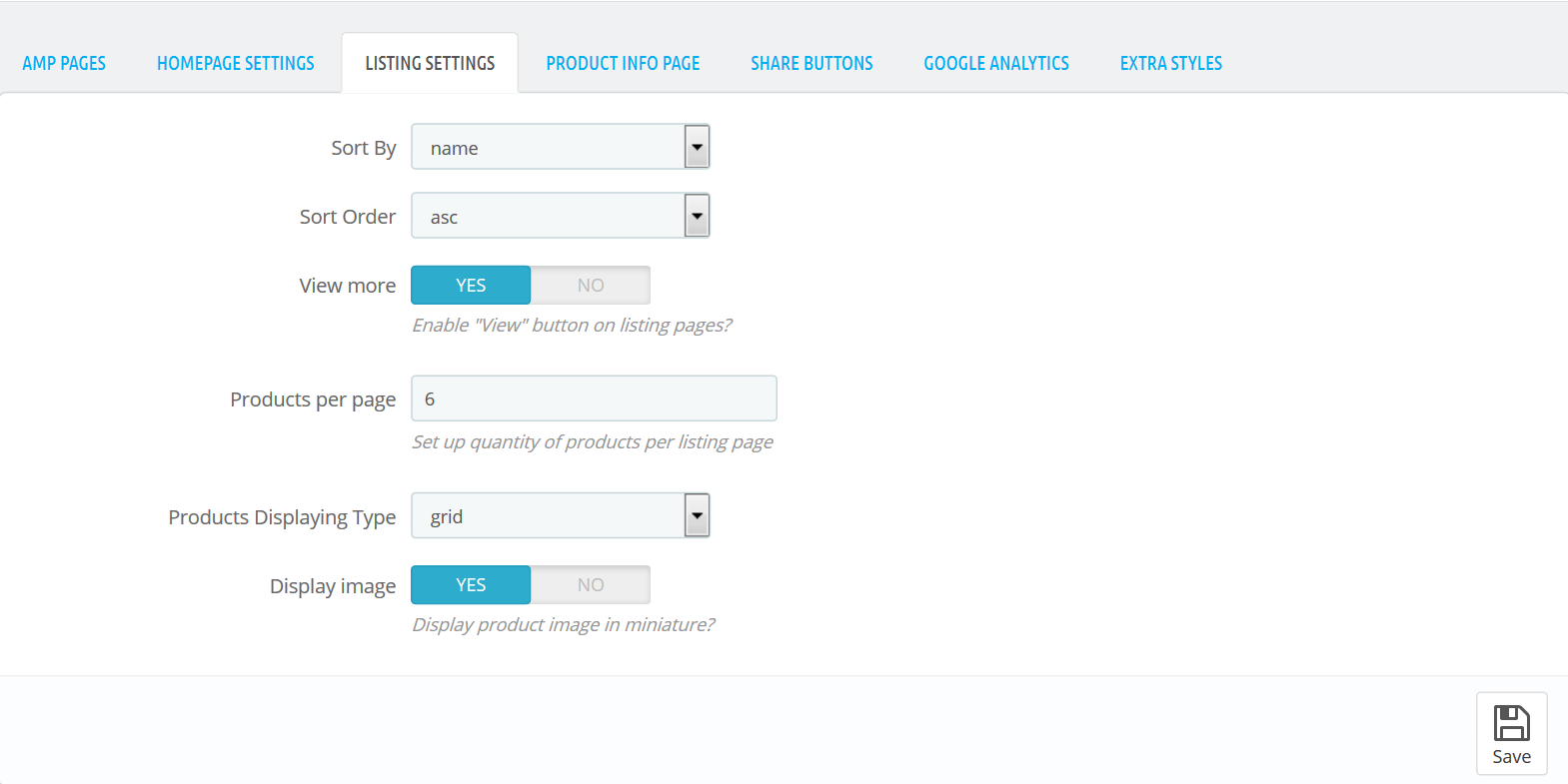
- Sort by:
- name - sort the products by their names;
- position - sort the products by their position;
- price - sort the products by the price.
- Sort Way:
- asc - sort the products in ascending order;
- desc - sort the products in descending order.
- View more - enable/disable the "Read more" button on the listing page.
- Products per page - set the quantity of the products per listing page.
- Products Displaying Type:
- list - present products vertically as a single continuous element.
- grid - present products in the form of the repeated pattern of cells arrayed vertically and horizontally.
- Display image - show/hide product image in miniature.
Product Info Page
You can set some additional settings for AMP Product Info Page.

- Extra images - display products' extra images on the product info page.
- Share buttons - enable/disable the share buttons (Facebook, Google+, Pinterest, Twitter).
Share Buttons
You may activate social share buttons on AMP pages in order to set social media sharing options on the product page.
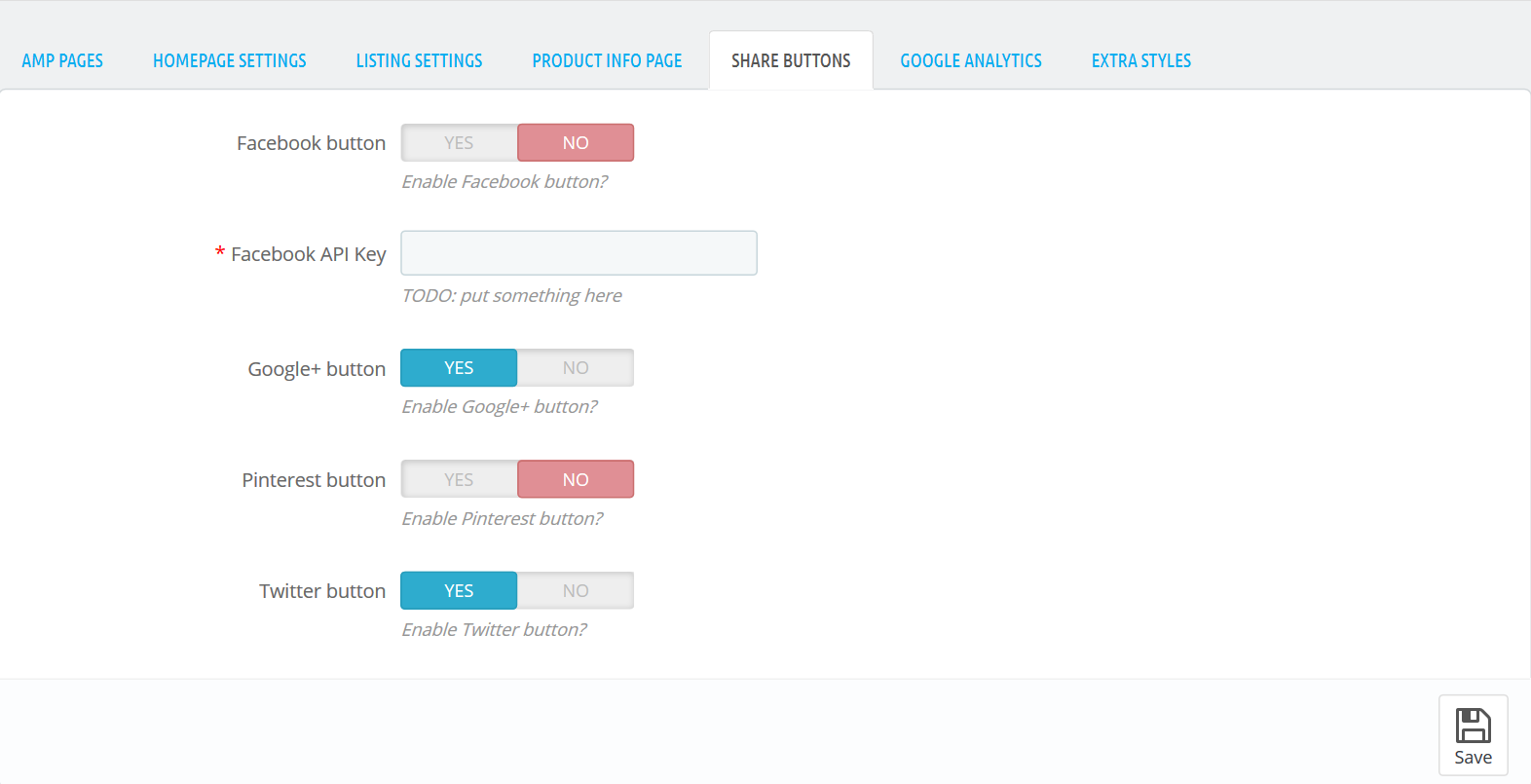
- Facebook button - enable/disable Facebook button.
- Facebook API Key - enter your Facebook API Key.
- Google+ button - enable/disable Google+ button.
- Pinterest button - enable/disable Pinterest button.
- Twitter button - enable/disable Twitter button.
Google Analytics
Make your accelerated mobile pages trackable by enabling Google Analytics.

- Status - enable/disable Google Analytics script.
- Google Analytic Key - enter your Google Analytics ID.
Extra Styles
Allows adding custom CSS styles.

- Main background color - the value can be set in any color format (rgb, hex, etc.). You can choose the color using the Color Picker tool.
JX Header Account 2.0.0
This module displays login and registration forms on the website. It can take the following positions: website header, left and right column. The module allows to log in and register using such social networks as Facebook, Google+ and VK, which is convenient for website users. Registration or logging in proceeds without reloading the page.
JX Header Account Main Panel
The main panel. Here you can set up the module.
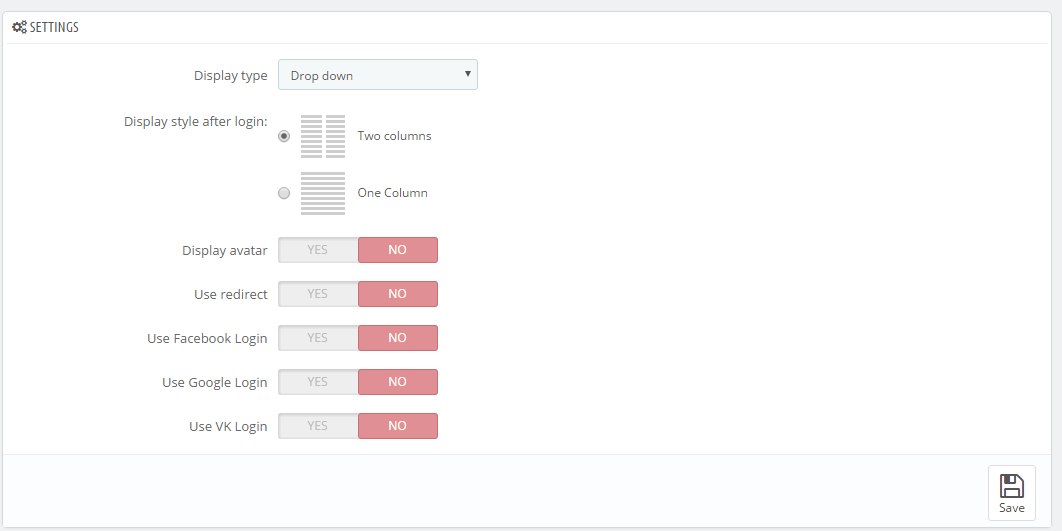
Settings
There are the following settings in the module:
Display type - this setting allows to select the way to display the registration form. It can take the following values:
- Drop down - the form will display as a drop-down below the button opening it.

- Popup - the form will appear in a pop-up.
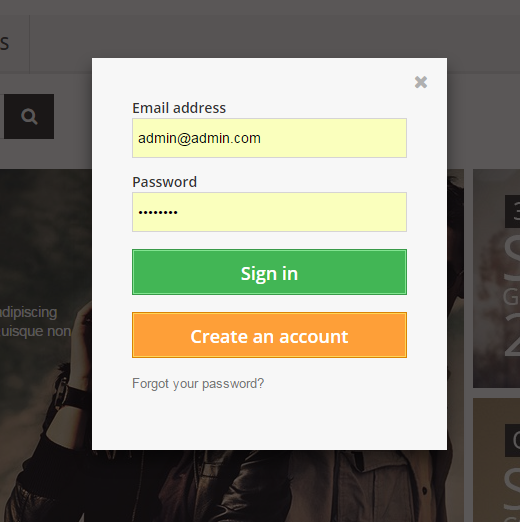
- Left side - the form will appear from the left as a sidebar.

- Right side - the form will appear from the right as a sidebar.
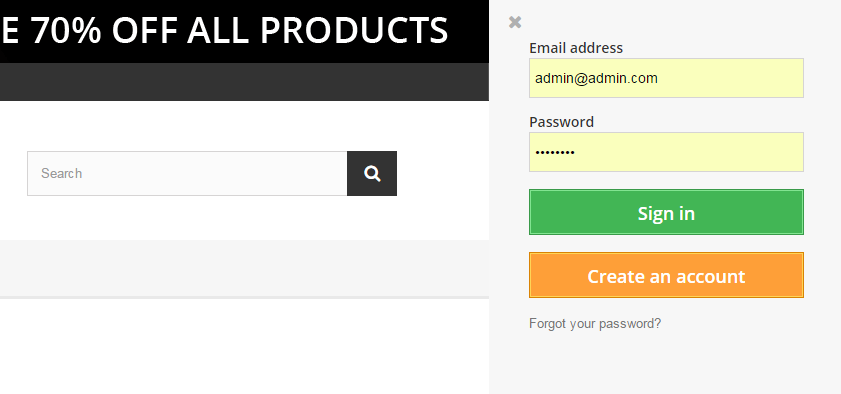
- Drop down - the form will display as a drop-down below the button opening it.
Display style after login - this setting allows to change the form view after login/registration. You can use the following values:
- Two columns - the list is divided into two columns.

- One Column - the list of links is displayed as one column.

- Two columns - the list is divided into two columns.
- Default avatar - this field appears only if the 'Display avatar' option is enabled. Here you can select the default user avatar.
- Display avatar - this setting allows enabling or disable user avatar. If the user logs in to the account on the website with the help of one of the social networks, the avatar will be taken from the account in this social network, otherwise, the avatar, loaded by the website admin, will be displayed.
- Use redirect - if this setting is enabled, user registration and password recovery will take place on the default PrestaShop registration/password recovery page.
Use Facebook Login - this setting allows enabling user registration and login with the help of the Facebook social network. When you enable this option, you will see the following settings:
- App ID - your account App ID from the Facebook developer account.
- App Secret - your app secret from the Facebook developer account.
Use Google Login - this setting allows enabling user login and registration with the help of the Google+ social network. If you enable this option, you will see the following settings:
- App ID - your App id from the Google developer account.
- App Secret - your App secret from the Google developer account.
- Redirect URLs - your online-store url + index.php?fc=module&module=jxheaderaccount&controller=googlelogin
Use VK Login - this setting allows enabling user registration and login with the help of VK social network. If you enable this option, you will see the following settings:
- App ID - your App id from your VK developer account.
- App Secret - App secret from your VK developer account.
- Redirect URLs - your online-store url + index.php?fc=module&module=jxheaderaccount&controller=vk
Registering apps in social networks:
- Facebook - to get App ID and App Secret, register your app at https://developers.facebook.com/apps.
You may check the following tutorial in order to learn how to create Facebook developer account and get App ID and App Secret values.
- Google+ - to get App ID and App Secret, register your app at https://developers.google.com/accounts/docs/OAuth2/.
- VK - to get App ID and App Secret register your app at https://vk.com/dev.
JX HTML Content
This module allows displaying any content (image, HTML, links, etc.) in the following positions: displayNav, home, top, topColumn, left and right (displayLeftColumn/displayRightColumn), footer. It is used to expand design opportunities and add advertisement/information blocks to your store. It is a multilanguage module and can also work on the multi-store website.
Installation and Deleting
The module can be installed and deleted like any other PrestaShop module.
Module configuration
After the module has been successfully installed, open the configuration page.
To add the content, you should follow the steps below:
- Click 'Add new' button.
- The list of available languages. You can view the available elements for all languages by switching the language tabs.
- The list of elements added for specific position and language.
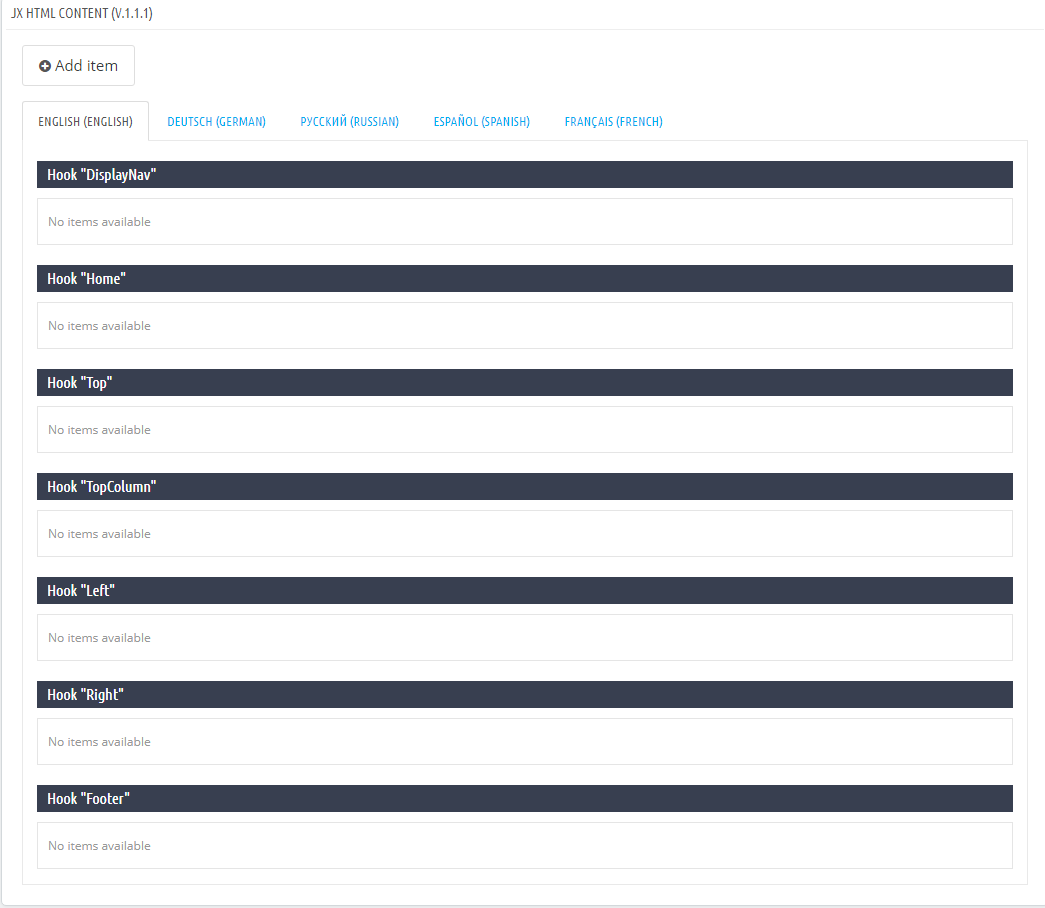
Adding the element. Click Add item button and fill in the required settings (none of the fields are mandatory).
All elements of one language added to the same position will be displayed as a list at the backend and frontend.
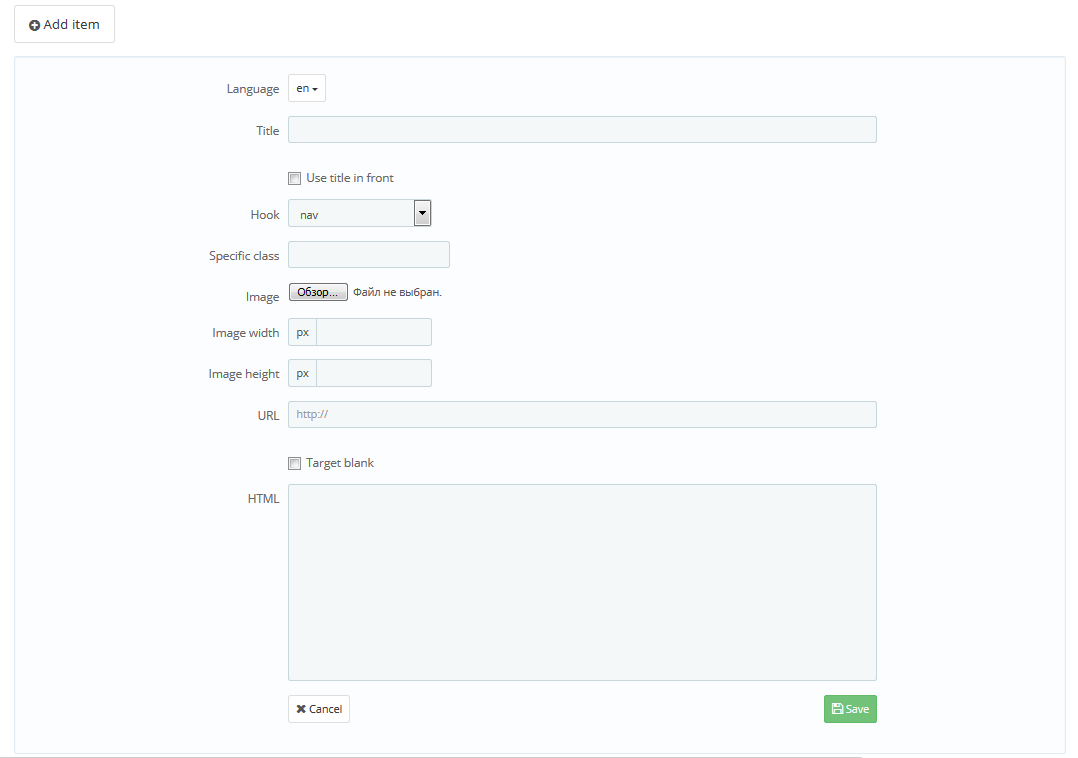
-
- Language
- select the required language from the drop-down list.
-
- Title
- title of the element.
-
- Use title in front
- display the title of the element at the frontend (the title will show up in front of the element).
-
- Hook
- position where the element is added.
-
- Specific class
- custom class defines item styling (CSS class).
-
- Image
- upload the image from your computer.
-
- Image width
- image width shown at the frontend.
-
- Image height
- image height shown at the frontend.
-
- URL
- add the link (the whole block will be wrapped in the link).
-
- Target blank
- open link in new tab.
-
- HTML
- HTML code (except the link if you have added it in the URL field) or text.
-
- Save
- click to save the element.
Editing and removing the element
When you add the element, it shows up in the corresponding list.
- The language where the elements were added.
- Position where the elements were added.
- Edit button with the drop-down list.
- Delete button.

Editing
Click Edit button to modify the element.
In the appeared screen change all the required fields.
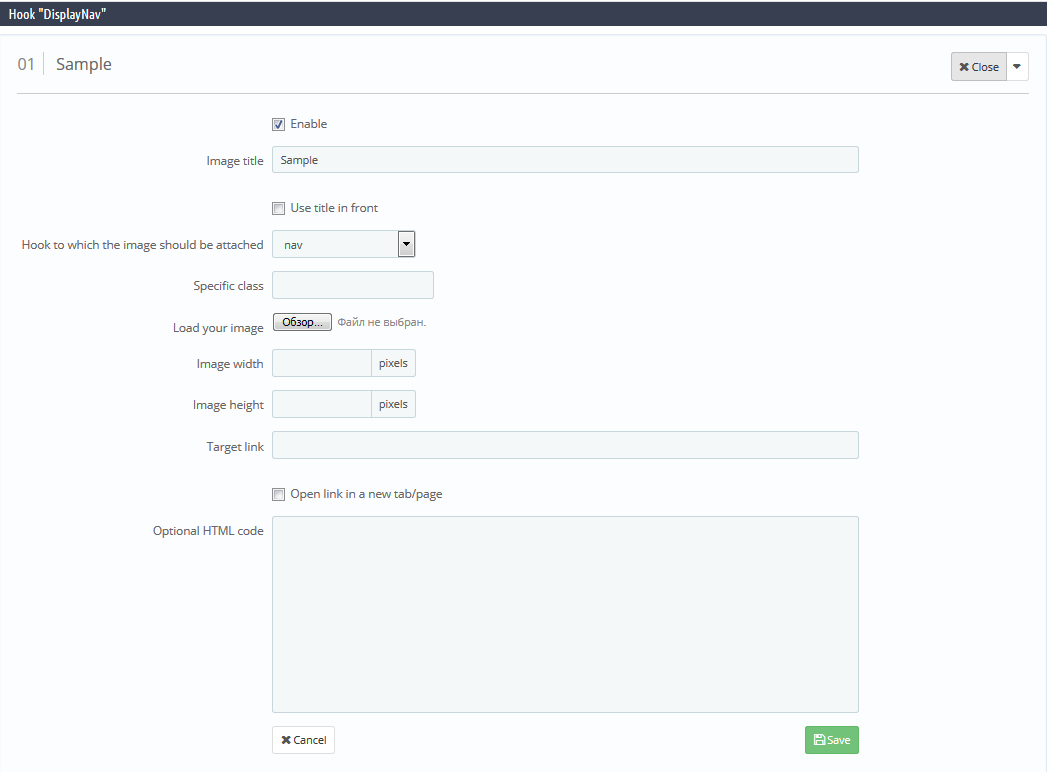
-
- Enable
- display the element at the frontend.
-
- Image title
- title of the element.
-
- Use title in front
- show up title at the frontend.
-
- Hook to which the image should be attached
- position of the element.
-
- Specific class
- custom CSS class.
-
- Load your image
- image of the element.
-
- Image width
- image width at the frontend.
-
- Image height
- image height at the frontend.
-
- Target link
- assign link to the element.
-
- Open link in a new tab/page
- Open link in new tab.
-
- Optional HTML code
- edit HTML code.
-
- Save
- save changes.
Changing order of elements in the list

To change the order of elements, you should just drag the element to the position you need.


JX Media Parallax 2.0.0
This module is designed to let you add a parallax effect to the DOM items of the page. It allows you to create multi-layered parallax. It also provides a possibility to add a custom background video (you can upload it from your computer to server) or add a YouTube video.
JX Media Parallax Main Panel
Main module panel that allows you to add, edit or remove parallax items.

Creating a new parallax item
In order to create a new parallax item, press 'plus' (1) icon, in the top right corner of the main panel.

Then you will see the following form.
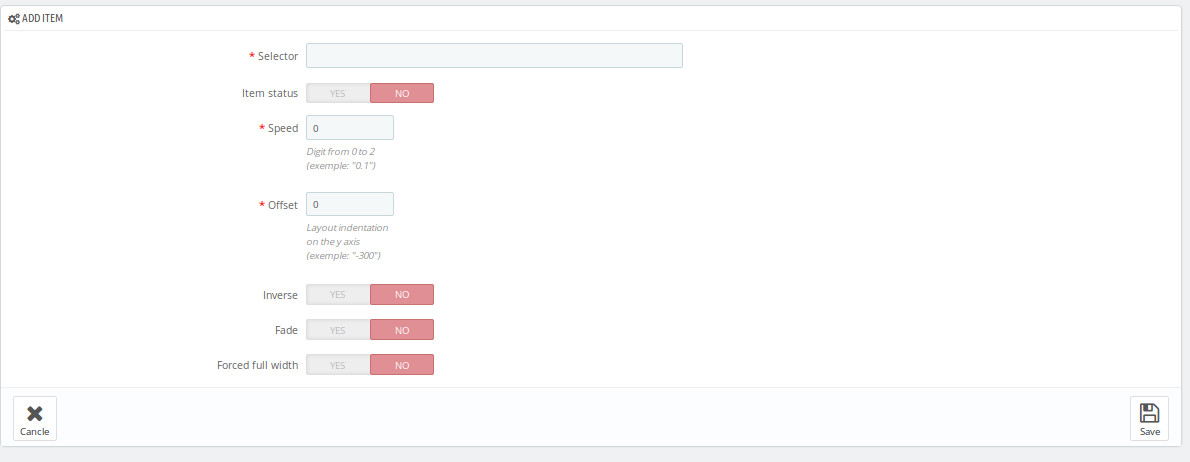
Form options for adding parallax items
- Selector - CSS selector of the item with parallax effect applied. For example, '#header .nav'
- Item status - item status (parallax will not be displayed if it's disabled)
- Speed - digit value from 0 to 2, which defines main parallax block speed
- Offset - main layer indent on the Y axis
- Inverse - parallax direction
- Fade - this option allows to configure main block fade-out on page scroll
- Forced full width - forced full width of the parallax block
Press 'Save' after filling in all the required fields.
Parallax layers list
In order to see the list of parallax layers, you should press 'View' (1) near the main parallax item.

Then you'll see a table, in which the layers are displayed after they are added.

Adding new layer
In order to create a new parallax layer, press 'plus' (1) icon in the top right corner of the layers panel.

Then you will see the following form.
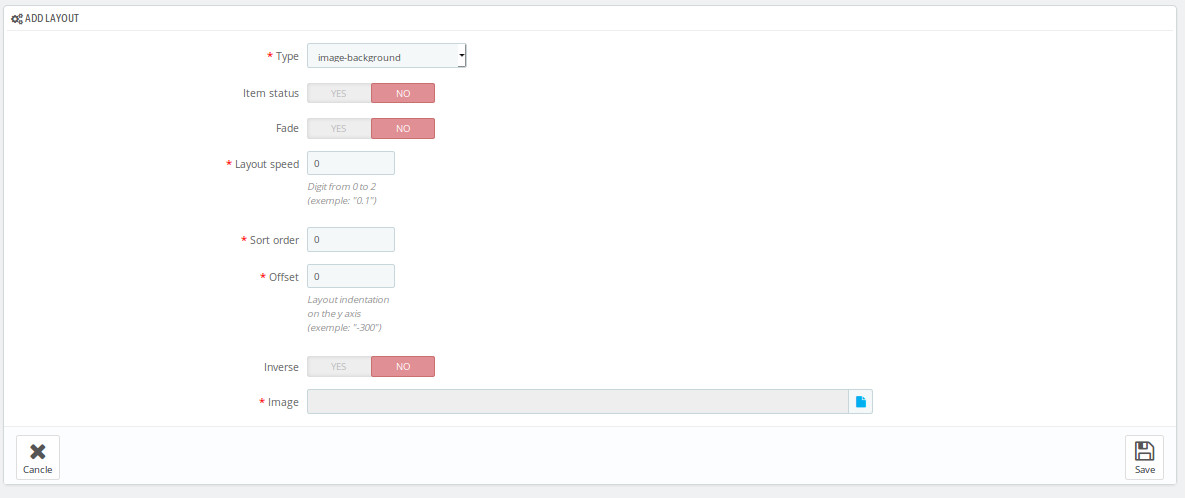
Press 'Save' after filling in all the required fields.
Parallax layers types and their fields
Image-background - image used as a parallax background
- Item status - item status (parallax will not be displayed if it's disabled)
- Layout speed - digit value from 0 to 2, which defines main parallax block speed
- Offset - main layer indent on the Y axis
- Inverse - parallax direction
- Fade - this option allows configuring main block fade-out on page scroll
- Image - link to an image, to which parallax effect will be applied
- Sort order - layout position, relative to the rest of items
Video-background - video used as a parallax background
- Item status - item status (parallax will not be displayed if it's disabled)
- Layout speed - digit value from 0 to 2, which defines main parallax block speed
- Offset - main layer indent on the Y axis
- Inverse - parallax direction
- Fade - this option allows configuring main block fade-out on page scroll
- Image - link to an additional image
- Video parallax mp4 - video in mp4 format
- Video parallax webm - video in webm format
- Sort order - layout position, relative to the rest of items
Text - text layer which position can be defined with CSS
- Item status - item status (parallax will not be displayed if it's disabled)
- Layout speed - digit value from 0 to 2, which defines main parallax block speed
- Offset - main layer indent on the Y axis
- Inverse - parallax direction
- Fade - this option allows configuring main block fade-out on page scroll
- Content - layer content
- Specific class - custom CSS class for this layer
- Sort order - layout position, relative to the rest of items
Youtube-background - YouTube video used as a parallax background
- Item status - item status (parallax will not be displayed if it's disabled)
- Layout speed - digit value from 0 to 2, which defines main parallax block speed
- Offset - main layer indent on the Y axis
- Inverse - parallax direction
- Fade - this option allows configuring main block fade-out on page scroll
- Video id - YouTube video ID
- Sort order - layout position, relative to the rest of items
Image - image layer which position can be defined with CSS
- Item status - item status (parallax will not be displayed if it's disabled)
- Layout speed - digit value from 0 to 2, which defines main parallax block speed
- Offset - main layer indent on the Y axis
- Inverse - parallax direction
- Fade - this option allows configuring main block fade-out on page scroll
- Image - link to an image, to which parallax effect will be applied
- Specific class - custom CSS class for this layer
- Sort order - layout position, relative to the rest of items
Uploading video and images to server
In order to upload video or an image to server via File Manager, first you need to press 'file' (1) icon next to the needed field.

In the following window, in the 'actions' line, choose 'upload' (2).
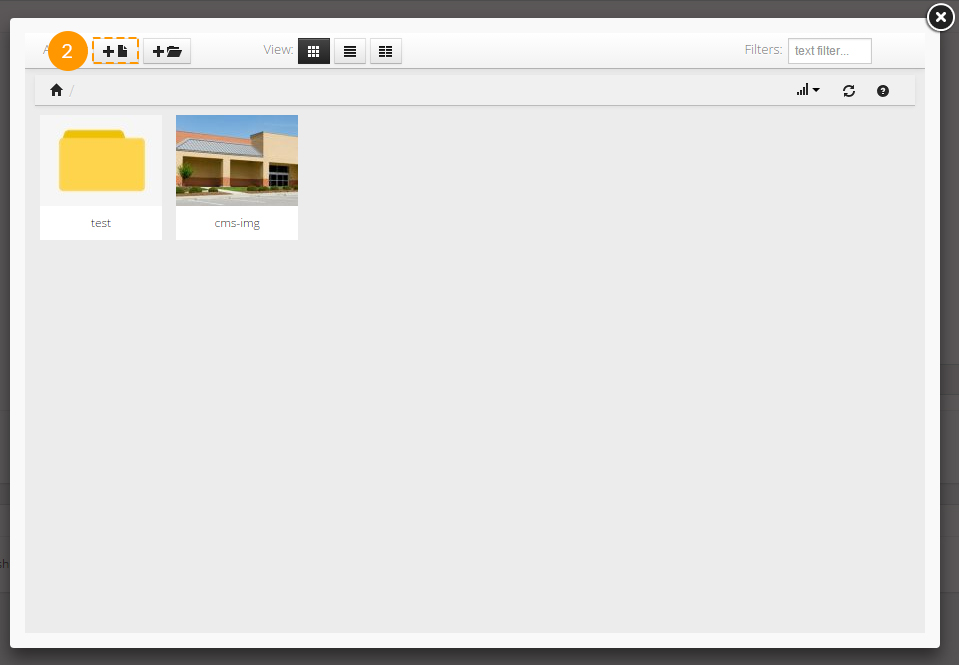
Then you'll see one more pop-up window, to upload image or video file here.
Warnings and recommendations
- Mobile devices (smartphones, tablets) have a parallax effect disabled by default, the uppermost block image layer is used as a background instead
- The forced full width of the parallax block affects page loading speed more critically than a regular full width block loading
- The smaller the size of the uploaded video, the better.
JX Mega Layout 1.4.0
The module allows building multiple homepage layouts (presets) for hooks. This module advantage is allowing you to create different hook markups and modify them up to your needs.
Module requirements
PrestaShop 1.7+
PHP 5.4+
Hooks
The module has 5 hooks available by default:
- 'Header' is a hook that combines such standard hooks: displayTop, displayNav, displayNav1, displayNav2. This hook corresponds to the website header.
- 'Top Column' corresponds to the displayTopColumn and displayNavFullWidth hooks. This hook comes right after the Header hook.
- 'Home' corresponds to such hooks: displayHome, displayWrapperTop, displayWrapperBottom, displayContentWrapperTop, displayLeftColumn, displayRightColumn. This hook is present only on the main page.
- 'Footer' corresponds to the displayFooterBefore, displayFooter and displayFooterAfter hooks.
- 'Product Footer' corresponds to the original displayFooterProduct hook, which is displayed in product page footer.
Integrating module to the theme
Integrating module to the THIRD-PARTY theme your presets won't be displayed at the frontend without this step.
NOTE: for third-party sources only if JX Mega Layout module is not included by default. The codes below have already been integrated into ZEMEZ template.
Header. In order to add custom preset to the Header hook, you need to perform the following steps:
- Open the /templates/_partials/header.tpl file for editing.
- Locate the following code:
{block name='header_banner'} <div class="header-banner"> {hook h='displayBanner'} </div> {/block} {block name='header_nav'} <nav class="header-nav"> <div class="container"> <div class="row"> <div class="hidden-sm-down"> <div class="col-md-5 col-xs-12"> {hook h='displayNav1'} </div> <div class="col-md-7 right-nav"> {hook h='displayNav2'} </div> </div> <div class="hidden-md-up text-sm-center mobile"> <div class="float-xs-left" id="menu-icon"> <i class="material-icons d-inline"></i> </div> <div class="float-xs-right" id="_mobile_cart"></div> <div class="float-xs-right" id="_mobile_user_info"></div> <div class="top-logo" id="_mobile_logo"></div> <div class="clearfix"></div> </div> </div> </div> </nav> {/block} {block name='header_top'} <div class="header-top"> <div class="container"> <div class="row"> <div class="col-md-2 hidden-sm-down" id="_desktop_logo"> <a href="{$urls.base_url}"> <img class="logo img-responsive" src="{$shop.logo}" alt="{$shop.name}"> </a> </div> <div class="col-md-10 col-sm-12 position-static"> {hook h='displayTop'} <div class="clearfix"> </div> </div> </div> <div id="mobile_top_menu_wrapper" class="row hidden-md-up" style="display:none;"> <div class="js-top-menu mobile" id="_mobile_top_menu"> </div> <div class="js-top-menu-bottom"> <div id="_mobile_currency_selector"></div> <div id="_mobile_language_selector"></div> <div id="_mobile_contact_link"></div> </div> </div> </div> </div> {hook h='displayNavFullWidth'} {/block} - And replace it with:
{assign var='displayMegaHeader' value={hook h='jxMegaLayoutHeader'}} {if $displayMegaHeader} {$displayMegaHeader nofilter} {else} {block name='header_banner'} <div class="header-banner"> {hook h='displayBanner'} </div> {/block} {block name='header_nav'} <nav class="header-nav"> <div class="container"> <div class="row"> <div class="hidden-sm-down"> <div class="col-md-5 col-xs-12"> {hook h='displayNav1'} </div> <div class="col-md-7 right-nav"> {hook h='displayNav2'} </div> </div> <div class="hidden-md-up text-sm-center mobile"> <div class="float-xs-left" id="menu-icon"> <i class="material-icons d-inline"> </i> </div> <div class="float-xs-right" id="_mobile_cart"></div> <div class="float-xs-right" id="_mobile_user_info"></div> <div class="top-logo" id="_mobile_logo"></div> <div class="clearfix"></div> </div> </div> </div> </nav> {/block} {block name='header_top'} <div class="header-top"> <div class="container"> <div class="row"> <div class="col-md-2 hidden-sm-down" id="_desktop_logo"> <a href="{$urls.base_url}"> <img class="logo img-responsive" src="{$shop.logo}" alt="{$shop.name}"> </a> </div> <div class="col-md-10 col-sm-12 position-static"> {hook h='displayTop'} <div class="clearfix"></div> </div> </div> <div id="mobile_top_menu_wrapper" class="row hidden-md-up" style="display:none;"> <div class="js-top-menu mobile" id="_mobile_top_menu"></div> <div class="js-top-menu-bottom"> <div id="_mobile_currency_selector"></div> <div id="_mobile_language_selector"></div> <div id="_mobile_contact_link"></div> </div> </div> </div> </div> {hook h='displayNavFullWidth'} {/block} {/if}
Top column. In order to add custom preset to the topColumn hook, you need to perform the following steps:
- Open the /templates/_partials/header.tpl file for editing.
- Locate the following code
{hook h="displayNavFullWidth"} - And replace it with:
{assign var='displayMegaTopColumn' value={hook h='jxMegaLayoutTopColumn'}} {if $displayMegaTopColumn} {$displayMegaTopColumn nofilter} {/if}
Home. In order to add custom preset to the Home hook, you need to perform the following steps:
- Open the /templates/layouts/layout-both-columns.tpl file for editing.
- Locate the following code:
<section id="wrapper"> {hook h="displayWrapperTop"} <div class="container"> {block name="breadcrumb"} {include file='_partials/breadcrumb.tpl'} {/block} {block name="left_column"} <div id="left-column" class="col-xs-12 col-sm-4 col-md-3"> {if $page.page_name == 'product'} {hook h='displayLeftColumnProduct'} {else} {hook h="displayLeftColumn"} {/if} </div> {/block} {block name="content_wrapper"} <div id="content-wrapper" class="left-column right-column col-sm-4 col-md-6"> {hook h="displayContentWrapperTop"} {block name="content"} <p> Hello world! This is HTML5 Boilerplate.</p> {/block} {hook h="displayContentWrapperBottom"} </div> {/block} {block name="right_column"} <div id="right-column" class="col-xs-12 col-sm-4 col-md-3"> {if $page.page_name == 'product'} {hook h='displayRightColumnProduct'} {else} {hook h="displayRightColumn"} {/if} </div> {/block} </div> {hook h="display wrapperBottom"} </section> - And replace it with:
<section id="wrapper"> {assign var='displayMegaHome' value={hook h='jxMegaLayoutHome'}} {if $page.page_name == 'index' && $displayMegaHome} {$displayMegaHome nofilter} {else} {hook h="displayWrapperTop"} <div class="container"> {block name="breadcrumb"} {include file='_partials/breadcrumb.tpl'} {/block} {block name="left_column"} <div id="left-column" class="col-xs-12 col-sm-4 col-md-3"> {if $page.page_name == 'product'} {hook h='displayLeftColumnProduct'} {else} {hook h="displayLeftColumn"} {/if} </div> {/block} {block name="content_wrapper"} <div id="content-wrapper" class="left-column right-column col-sm-4 col-md-6"> {hook h="displayContentWrapperTop"} {block name="content"} <p>Hello world! This is HTML5 Boilerplate.</p> {/block} {hook h="displayContentWrapperBottom"} </div> {/block} {block name="right_column"} <div id="right-column" class="col-xs-12 col-sm-4 col-md-3"> {if $page.page_name == 'product'} {hook h='displayRightColumnProduct'} {else} {hook h="displayRightColumn"} {/if} </div> {/block} </div> {hook h="displayWrapperBottom"} {/if} </section>
Footer. In order to add custom preset to the Footer hook, you need to perform the following steps:
- Open the /templates/layouts/layout-both-columns.tpl file for editing.
- Locate the following code:
{block name="footer"} {include file="_partials/footer.tpl"} {/block} - And replace it with:
{assign var='displayMegaFooter' value={hook h='jxMegaLayoutFooter'}} {if $displayMegaFooter} {$displayMegaFooter nofilter} {else} <div class="container"> {block name="footer"} {include file="_partials/footer.tpl"} {/block} </div> {/if}
Product footer. In order to add custom preset to the Product footer hook, you need to perform the following steps:
- Open the /templates/catalog/product.tpl file for editing.
- Locate the following code:
{block name='product_footer'} {hook h='displayFooterProduct' product=$product category=$category} {/block} - And replace it with:
{block name='product_footer'} {assign var='displayMegaProductFooter' value={hook h='jxMegaLayoutProductFooter' product=$product category=$category}} {if $displayMegaProductFooter} {$displayMegaProductFooter nofilter} {else} {hook h='displayFooterProduct' product=$product category=$category} {/if} {/block}
Module configuration
After JX Mega Layout module installation, you can configure it by clicking the Configure button (2).
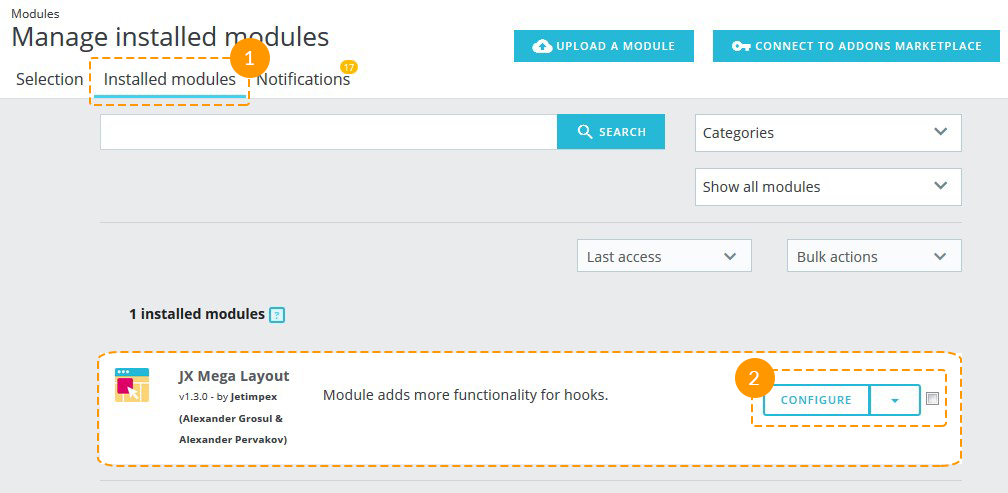
JX Mega Layout Main Panel
Main Layouts
The main JX Mega Layout module configuration panel allows you to add a preset to the required hook and configure the preset.

Adding the preset
-
Press '+ Add a Preset' (1) in the needed tab.

-
Next, fill in the 'Enter layout name' field in the popup typing the new preset (2) title there and press 'Save' (3).
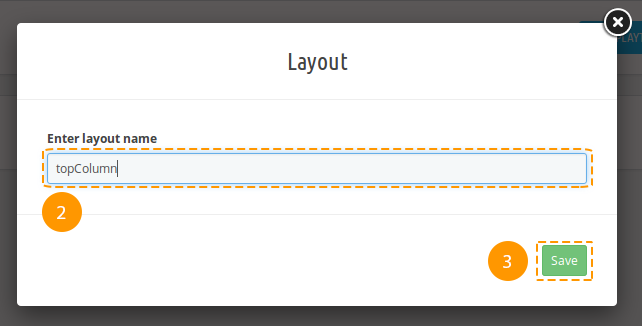
-
Preset was successfully created, it's listed among the available presets (4) now. Newly created preset is selected for editing (5).

Preset activation
-
First of all, select the needed preset from the list (1).

-
Press the 'Use as default' (2) switcher.

-
The preset was activated. If you need to display this preset only on some pages, open the drop-down (3) and select the pages you need. To apply changes, click outside the list area. A preset that is displayed on all pages will be marked with a filled star in the presets list, and the one that is displayed only on some pages will be marked with a partially filled star.

Removing the preset
There is no option to restore the preset after removing.
-
In order to remove the preset, choose the required preset among the list (1).

-
Next, press a cart (2) near the preset title.

-
Preset was successfully removed.
Renaming the preset
-
In order to rename the preset, choose the required preset among the list (1).

-
Next, press a pencil icon (2) next to the preset title.

-
Specify the new preset title (3) in a popup and press 'Rename layout' (4).
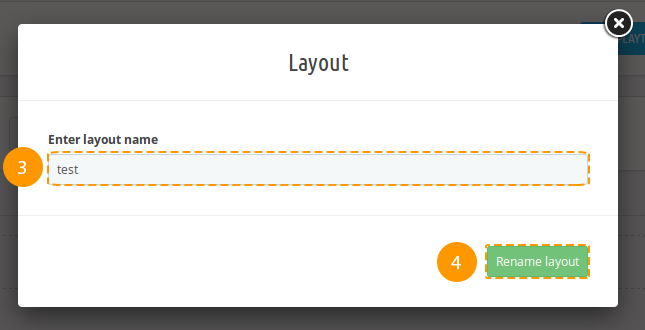
-
Preset was successfully renamed.
Wrapper
Wrapper has no class by default, it's not a mandatory item.
Adding the wrapper
-
In order to create a wrapper, press '+ Add wrapper' (1).

-
Wrapper was added (2).

Adding the custom CSS class to the wrapper
Adding the custom class will let you create a specific styling for your wrapper by using CSS rules.
-
In order to add wrapper class, press the button (1).

-
You'll see a pop-up window, fill in the 'Enter wrapper classes' (2) field there and press a 'Confirm' (3) button.
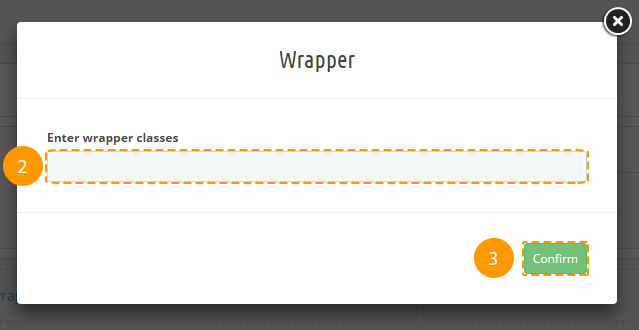
-
Custom class was added successfully.
Deleting the wrapper
Deleting the preset item will also cause all of its child items and their styles removing.
-
In order to remove the wrapper, press the cart button (1).

-
Wrapper was removed successfully.
Styling the wrapper
-
In order to add custom styles to the wrapper, press the 'pencil' (1) icon in the wrapper block.

-
In the following pop-up window fill in all the needed fields (you may refer to the documentation 'Styling' section), and press 'Save' (2) button.
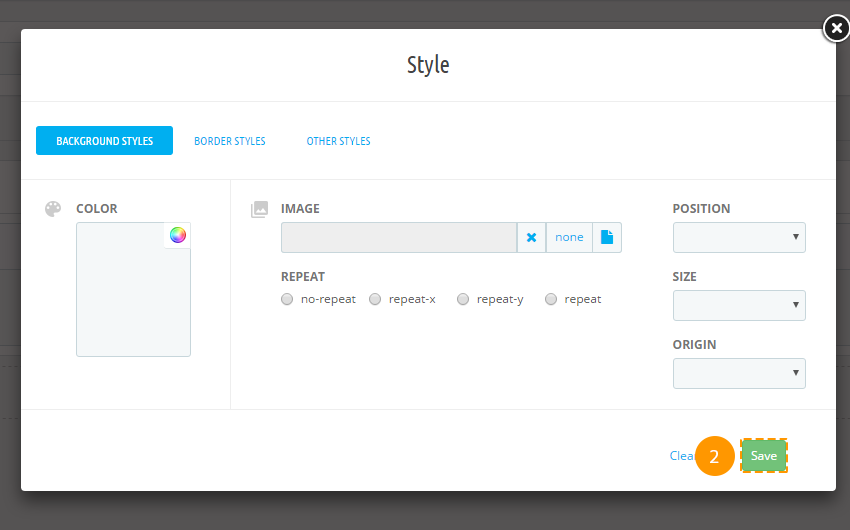
-
If all the fields are filled in correctly, styles will be saved.
Row
Row item from the Bootstrap grid. It's a required item.
Adding the row
-
In order to insert a new row, press '+ Add row' (1) into the wrapper block, or '+ Add row' (2) in the main preset block, or '+ Add row' (3) in the column drop-down list.
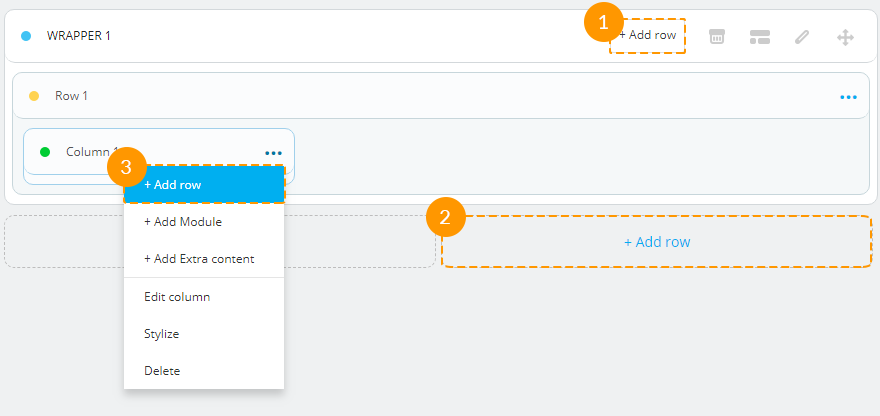
-
The row was added successfully.
Adding custom CSS class to the row
Custom class adding allows you to create custom row styling using CSS rules.
-
In order to add the class to the row, you should press the 'ellipsis' button (1).

-
Choose the 'Edit row' (2) in a drop-down list.

-
Fill in the 'Enter row classes' (3) field in the pop-up window and press 'Confirm' (4) button.
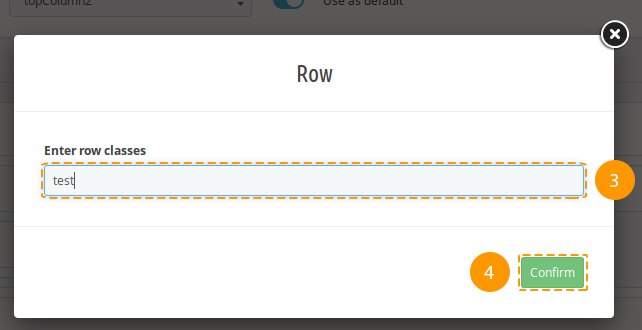
-
Custom class was added successfully.
Deleting the row
Removal of preset item will also cause removal of its child items and their styles.
-
In order to remove the row, open the menu (the 'ellipsis' icon) in the row block.

-
Choose 'Delete' (2) option in the drop-down.

-
The row was successfully removed.
Adding styles to the row
-
In order to add row styles, open the menu (the 'ellipsis' icon) (1) in a row block.

-
Press 'Stylize' (2) in the drop-down.

-
You will see the pop-up window, fill in all the needed fields there (you may refer to the documentation 'Styling' section) and press 'Save' (3) button.
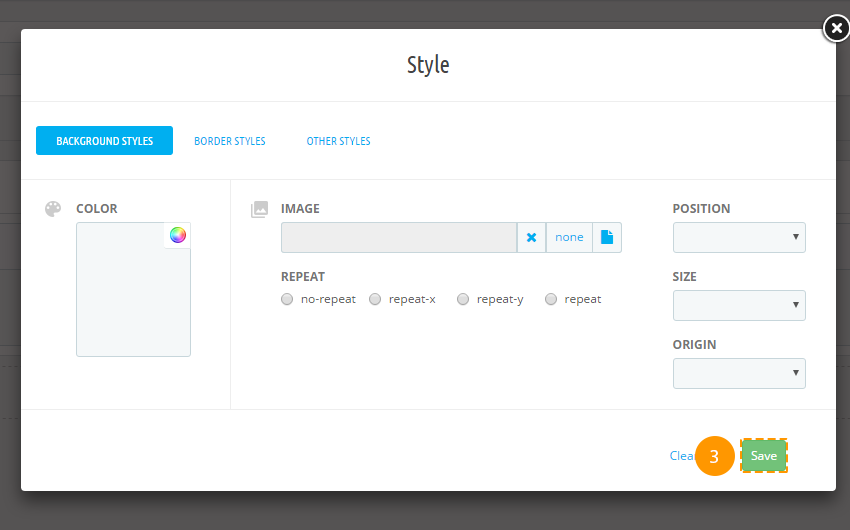
-
If all the fields are filled in correctly, styles will be saved.
Column
It is an item with configurable block width for different dimensions, based on Bootstrap grid.
Adding the column
-
In order to insert a column into a needed 'row', open the menu (the 'ellipsis' icon) (1)

-
Choose the '+ Add Col' (2) among the list.

-
Fill in the fields (col*, col-sm*, col-md*, col-lg*, col-xl*, col-xxl* - in accordance with bootstrap 4 requirements) in the pop-up window and press 'Confirm' (3) button.
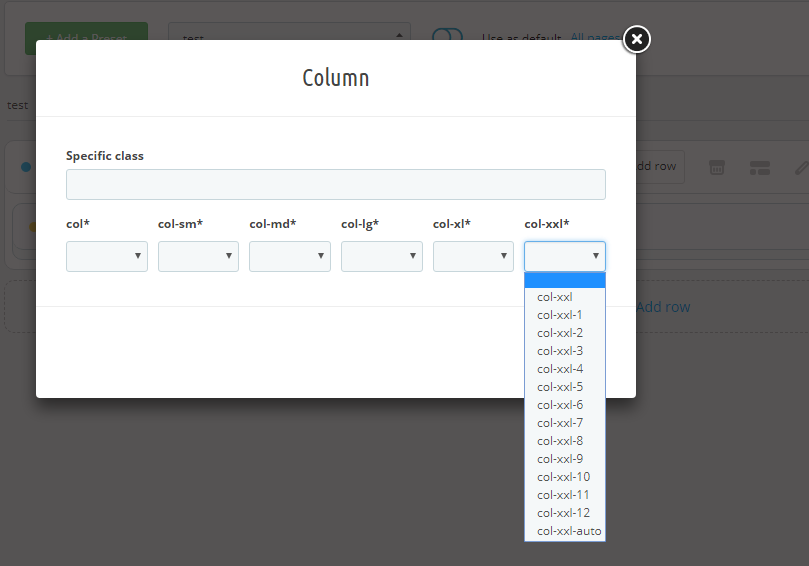
-
The column was added successfully.
Removing the column
Preset item removing will also cause its child items and their styles deleting.
-
In order to remove the column, open the menu (the 'ellipsis' icon) in a column block (1)

-
Press 'Delete' (2) in the list.
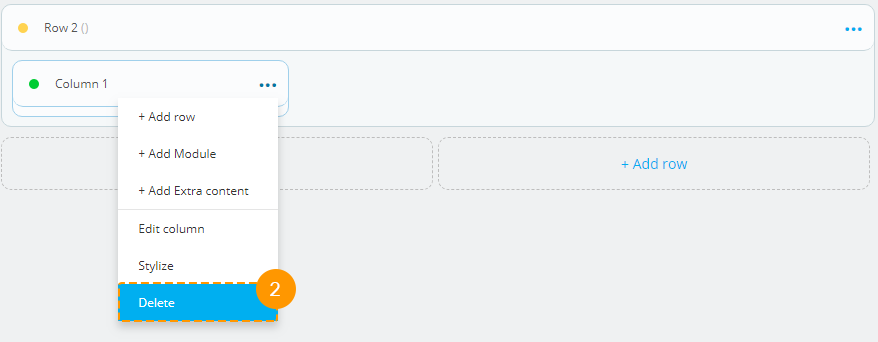
-
The column and all of its child items were removed.
Editing the column
-
In order to edit the column, open the menu (the 'ellipsis' icon) (1) in the column block.

-
Press 'Edit column' (2) in the list.
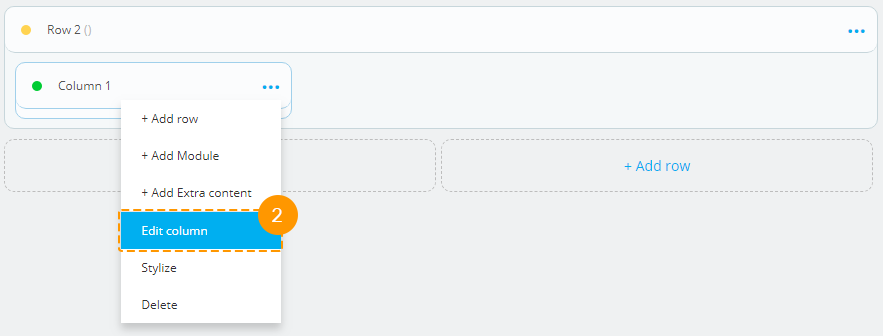
-
Fill in the fields (col*, col-sm*, col-md*, col-lg*, col-xl*, col-xxl* - in accordance with bootstrap 4 requirements) in the pop-up window and press 'Confirm'.
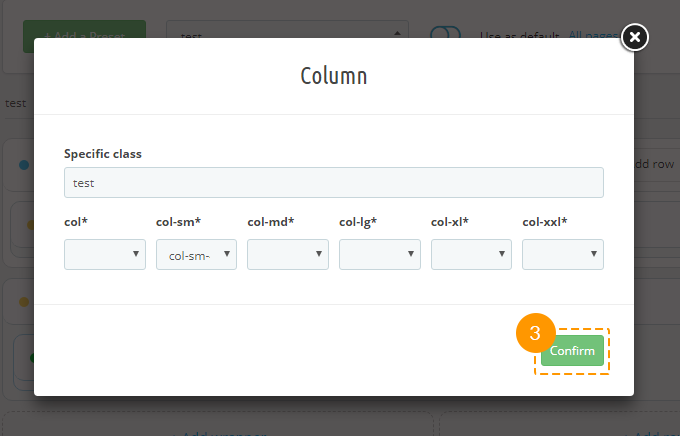
-
The column was successfully edited.
Adding styles to the column
-
In order to add column styles, open the menu (the 'ellipsis' icon) (1) in a column block.

-
Press 'Stylize' (2) in the list of options.
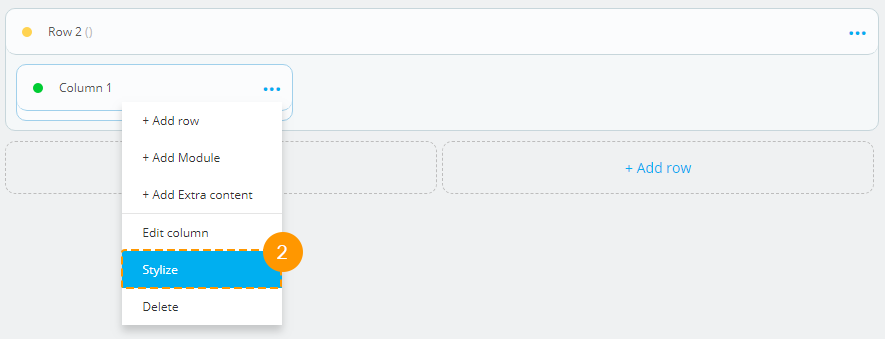
-
You will see the pop-up window, fill in all the needed fields there (you may refer to the documentation 'Styling' section) and press 'Save' (3) button.
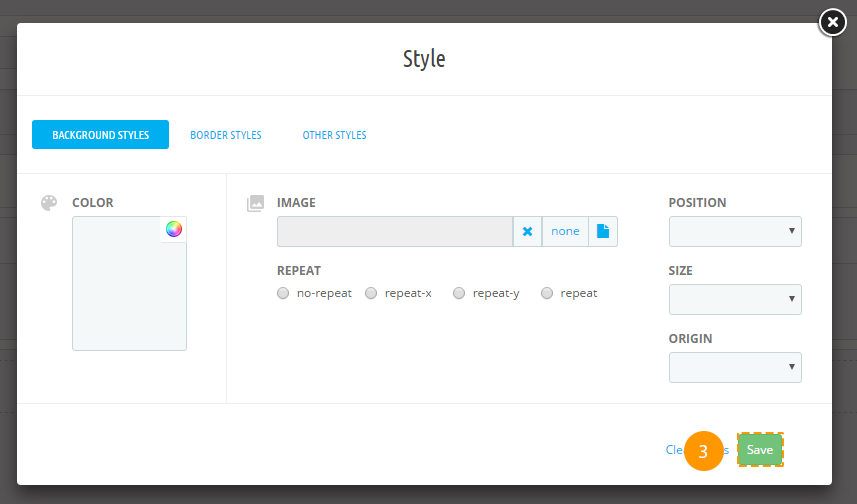
-
If all the fields are filled in correctly, styles will be saved.
Module
Module assigned to this hook.
Adding the module
Be careful when adding modules to the preset, some modules are desirable to use if they do not change the visible layout, e.g., 'Data mining for statistics' module.
-
In order to add the module to the preset in a column block, open the menu (the 'ellipsis' icon) (1).

-
Press the '+ Add Module' (2) in the list of options available.
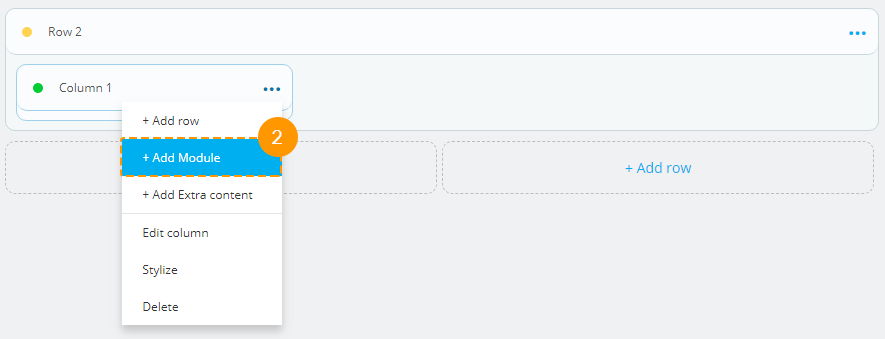
-
If needed, you can enter the custom class (3) in the pop-up window and select the module (4), next press 'Confirm' (5).

-
The module was successfully added.
-
In this version of JX Mega Layout you can add 'Homepage tabs' module in Home hook.

It can also be customized like all other modules in Mega Layout.
Deleting the module
Removal of preset item will also cause removal of its child items and their styles.
-
In order to remove the module, open the menu (the 'ellipsis' icon) (1) in the module block.

-
Press 'Delete' (2) in the list of options available.

-
The module is removed.
Adding custom class to the module
Custom class adding allows to create module styling using CSS rules.
-
In order to specify custom class for the module, open the menu in the module block (the 'ellipsis' icon) (1).

-
Press 'Edit Settings' (2) then.

-
Specify custom class (3) in the pop-up window and press 'Confirm' (4) button.

-
Custom class was added.
Extra content
Additional custom content in any position.
Adding extra content
-
In order to add extra content in a column block, open the menu (the 'ellipsis'icon) (1).

-
Press 'Add Extra content' (2).

-
The pop-up window will appear. Specify the custom class (3), if needed. You need to select the content type (product or post) (4) and identify product ID number (5). Press 'Confirm' (6) button.
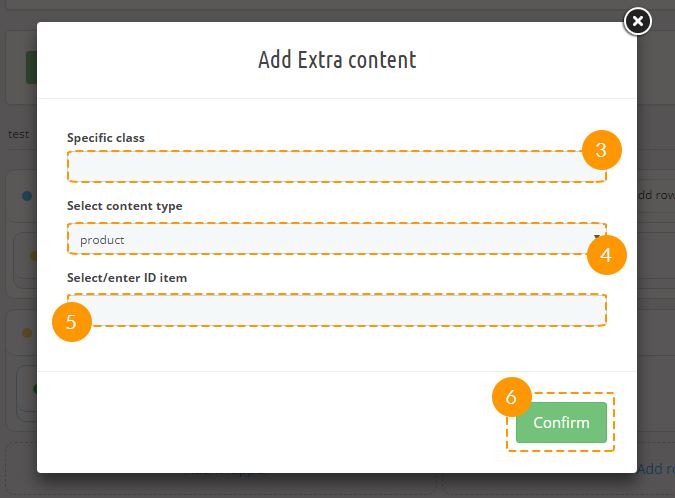
-
Extra content was successfully added.

Deleting extra content
-
To remove the extra content, open the menu (the 'ellipsis' icon) (1) in the corresponding block.

-
Press 'Delete' (2) button.

Adding custom class to the extra content
-
In order to add the custom class for the extra content, open the menu in the corresponding block (the 'ellipsis' icon) (1).

-
Press 'Edit settings' (2) button.

-
Specify the custom class in the appeared pop-up window. Press 'Confirm' button.

- Custom CSS class was added.
Logo, Copyright
Logo and Copyright blocks are edited the same way as modules, except for the fact that Logo can be placed only in Header or Footer position, and the Copyright block can be placed only in Footer position.
Presets export
Export tool allows you to export presets for the further import into different shops.
-
Navigate to the 'Tools' (1) tab in the main configurations panel.

-
Choose 'Export' (2) in the form.

-
You'll see the list of the existing presets in site hooks.

-
In order to preview the preset, press 'Layout preview' (3) button next to the preset you need, in order to export, please press 'Export layout' (4) button.

-
Then you'll be able to download this preset as a zip archive.
Preset import
Import tool accepts only the presets *.zip files that were previously generated with the same module Export tool.
-
In order to import your preset, you should open the Tools (1) tab and choose 'Import' (2).
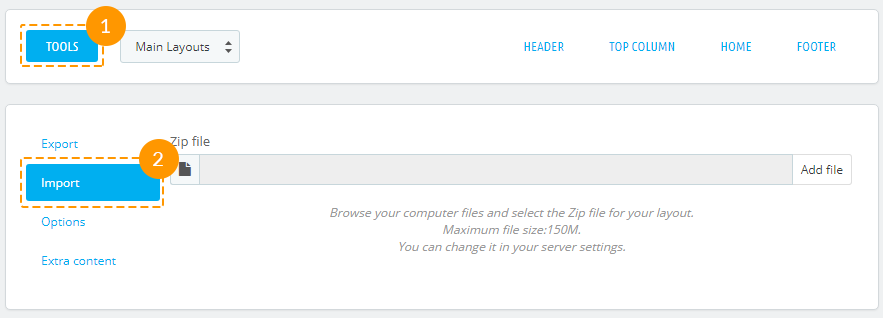
-
Next, press the Add file (3) button and select the zip file of your exported preset. In case this archive is the exported preset, you will see this preset preview.

-
If this preset meets your needs, press 'Import' (4). The preset will be imported and added to the list of available presets.

Reset
'Reset' reverts all the presets to initial state (to the way they came with the template), and discards all the created presets.
Attention! After reverting presets to default state, all the custom presets will be discarded!
-
To reset presets, navigate to the 'Tools' (1) tab. In the appeared block open the 'Options' (2) tab.
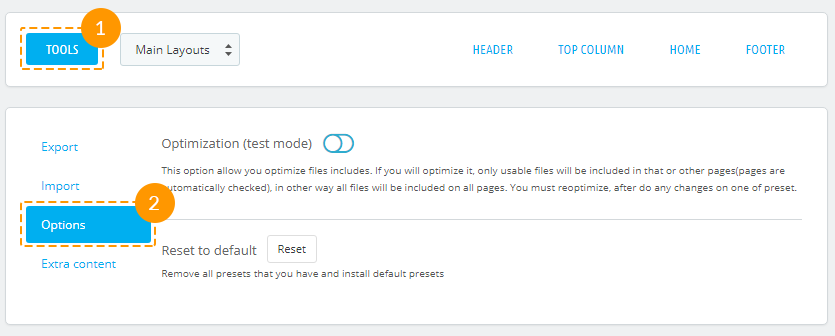
-
Press the 'Reset' button.

-
That's it! All presets are reset to initial state.
Styles and Scripts Optimization
Styles and scripts optimization adds exclusions for modules in Header section, based on their use in presets. This allows speeding up the page loading speed. Optimization works in test mode.
Enabling optimization:
-
To enable optimization, open the 'Tools' (1) tab and select the 'Options' (2) tab.

-
In the appeared window, you can enable optimization (3).

If optimization is enabled when editing and enabling presets, optimization gets discarded, but you'll see a window offering to run optimization. There is no need to optimize scripts and styles every time you change presets. It's better to optimize them when you're done editing.

Styling
-
Background styles. Fields description:
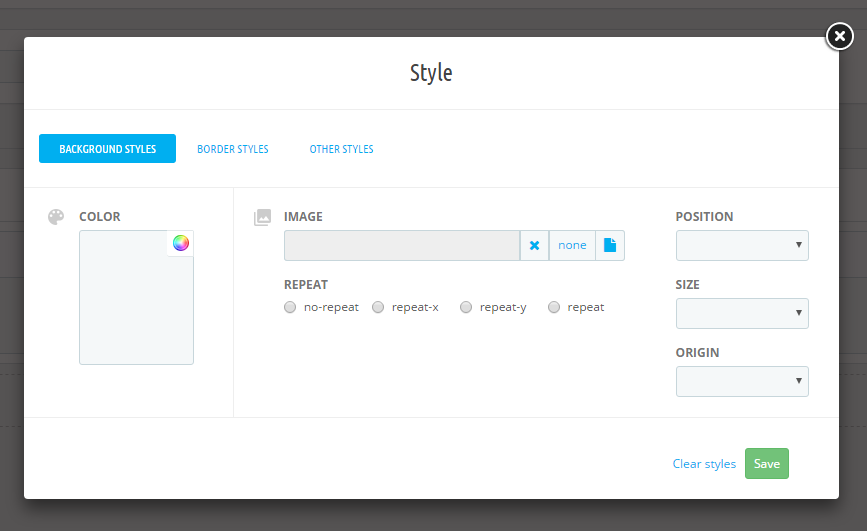
- background-image (background image) - the image URL or 'none' value. The image is picked from the ~/images/cms/ folder.
- background-color (background color) - the value can be set in any color format (rgb, hex, etc.). You can choose the color using the Color Picker tool.
- background-repeat (background repeat) - all the available options are listed in the radio buttons.
- background-position (background position) - all the available options are listed in the drop-down.
- background-size (background size) - all the available options are listed in the drop-down.
- background-origin (background image positioning region) - all the available options are listed in the drop-down.
Border styles.
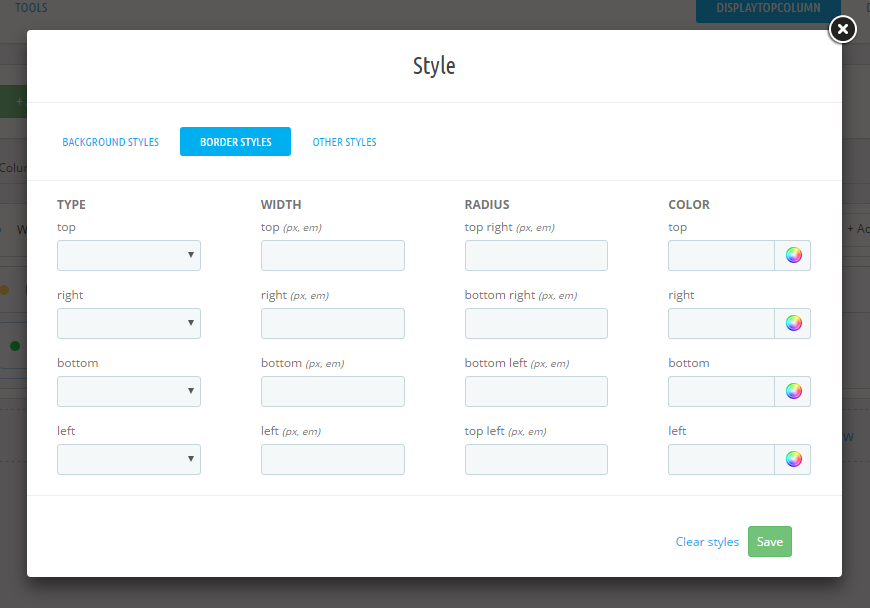
- border-top-style, border-right-style, border-left-style, border-bottom-style (border styles) - all the available options are listed in the drop-down.
- border-top-width, border-right-width, border-left-width, border-bottom-width (borders width) - should be set in pixels.
- border-top-сolor, border-right-color, border-left-color, border-bottom-color (borders color) - the value can be set in any color format (rgb, hex, etc.). You can choose the color using the Color Picker Tool.
- border-top-right-radius, border-top-left-radius, border-bottom-right-radius, border-bottom-left-radius (border radius) - should be set in pixels.
Other styles.
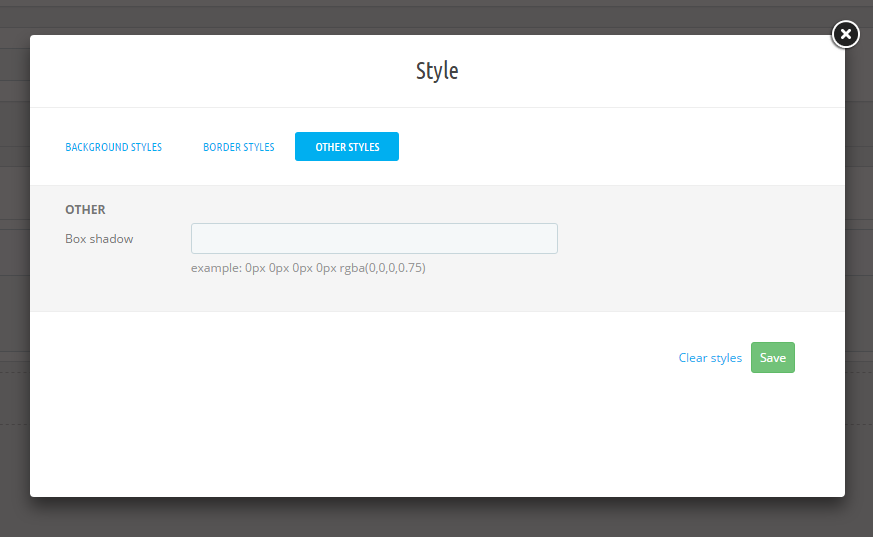
- box-shadow (box shadow) - example:0px 0px 0px 0px rgba(0,0,0,0.75).
Items styles removing
-
In order to remove items styles, open the items styling section and press 'Clear styles' (1)
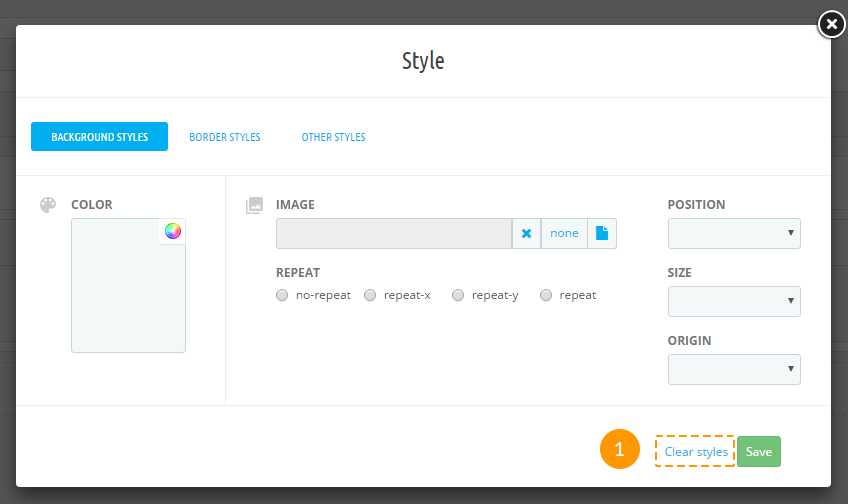
Extra content
On the module base there is the ability to create one of the available content types (HTML block, Banner block, YouTube block or Slider block) blocks and, also, output the products or posts as slides. You can also Export all the extra content you have created in one click only or import it from your computer.
-
In order to add extra content, you should open the Tools (1) tab and choose 'Extra content' (2.)
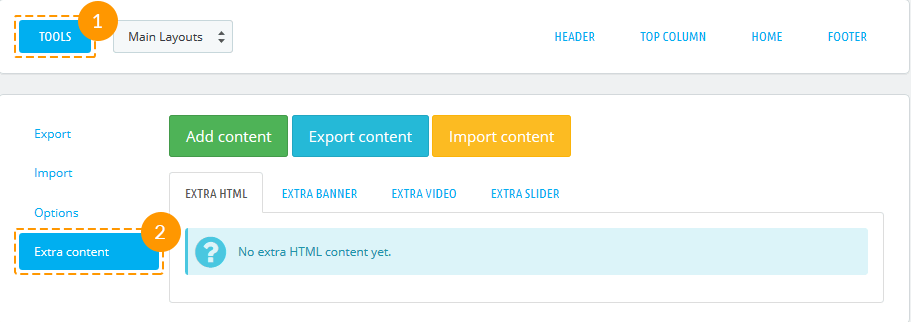
-
Press 'Add content' button.

-
There are 4 available types of content that you can create: HTML block, Banner block, Video block, Slider block.

Extra HTML content
-
To create extra HTML content, press 'Create HTML block' tab.

-
In the form that appears, fill in the required fields.
-
- Enter HTML item name
- HTML block name, is mandatory to be filled in for the default language.
-
- HTML content
- HTML content.
-
- Enter Specific Class
- block CSS class.

-
-
To delete HTML block, press 'Remove' (1) button. In order to edit block, press 'Edit'(2) button.

Extra Banner content
-
To create extra Banner content, press 'Create Banner block' (1) tab.

-
In the form that appears, fill in the required fields.
-
- Enter Banner item name
- banner title, is mandatory to be filled in for the default language.
-
- Enter Banner item link
- a link that is assigned to this banner.
-
- Add banner image
- upload an image for the banner.
-
- Banner content
- set the content of the banner.
-
- Enter Specific class
- block CSS class.
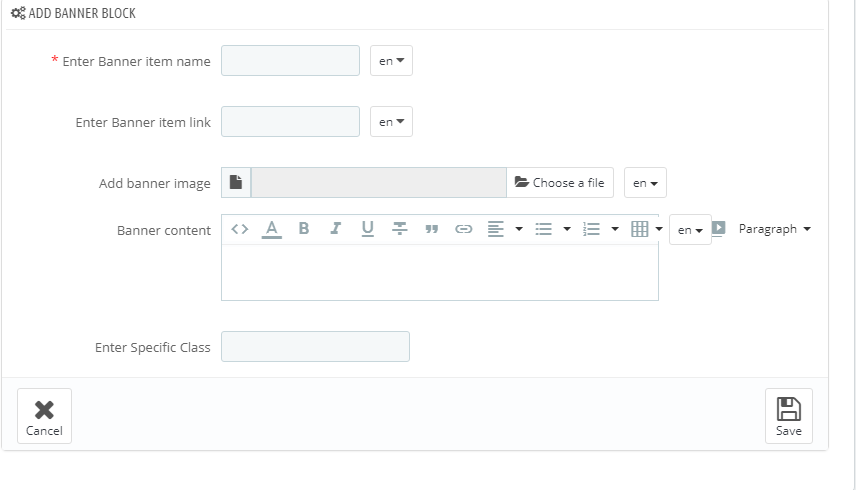
-
-
To delete Banner block, press 'Remove' (1) button. In order to edit block, press 'Edit'(2) button.

Extra Video content
-
In order to create extra Video content, press 'Create Video block' (1) tab.

-
In the form that appears, fill in the required fields.
-
- Enter Video item name
- the title of the video (mandatory).
-
- Preview
- the video will be displayed before it will be published.
-
- Enter Video item URL
- add video link in the YouTube video format.
-
- HTML content
- the field where some HTML content can be added.
-
- Enter Specific Class
- block CSS class.
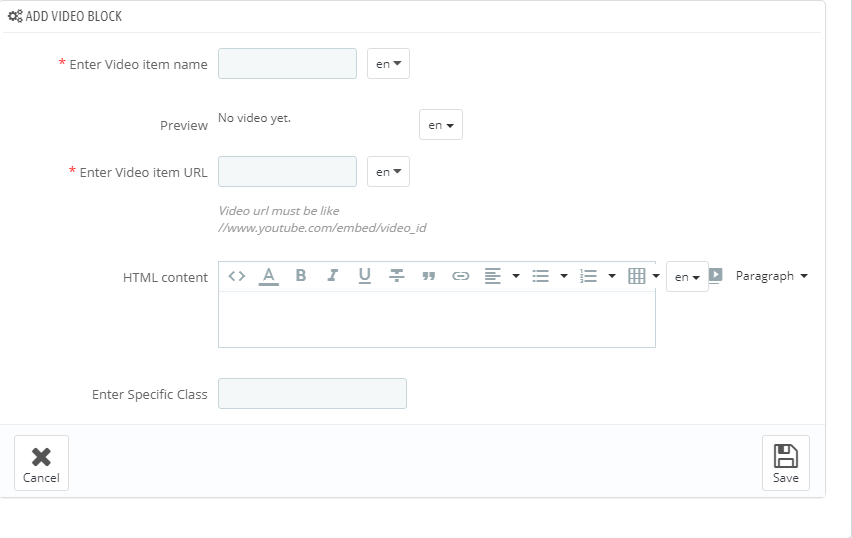
-
-
To delete Video block, press 'Remove' (1) button. In order to edit block, press 'Edit'(2) button.
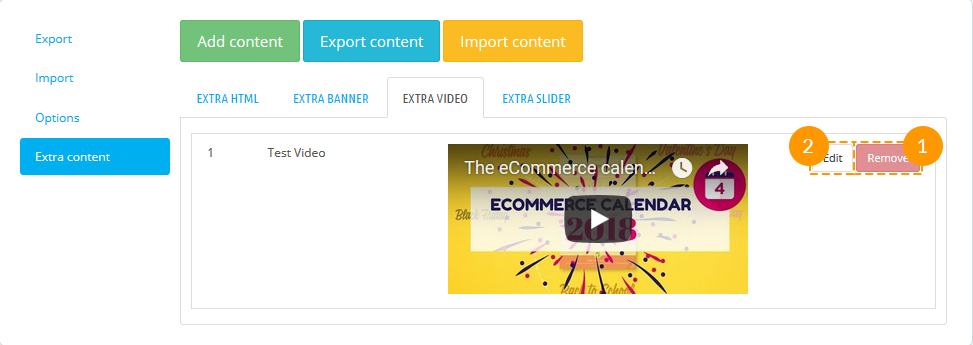
Extra Slider content
-
In order to create extra Slider content, press 'Create Slider block' (1) tab.

-
In the form that appears, fill in the required fields.
-
- Enter Slider item name
- the title of the slider (mandatory).
-
- Slider description
- set the description of the slider.
-
- Enter Specific class
- block CSS class.
-
- Slides
- the content of the slide: html, banner, video, product, post.
-
- Visible items
- the number of visible items (mandatory).
-
- Items scroll
- the number of items changed with one scroll (mandatory).
-
- Slide margin
- the carousel list item margin (mandatory).
-
- Slider speed
- speed of changing speed (mandatory).
-
- Auto scroll
- turns on/off slider autoplay.
-
- Pause
- pause between scrolls (if 'Auto scroll' is enabled).
-
- Slider Loop
- allow repeating slides from the beginning after all the slides were shown.
-
- Pager
- show/hide slider pagination.
-
- Controls
- show/hide slider navigation.
-
- Auto height
- slides height.
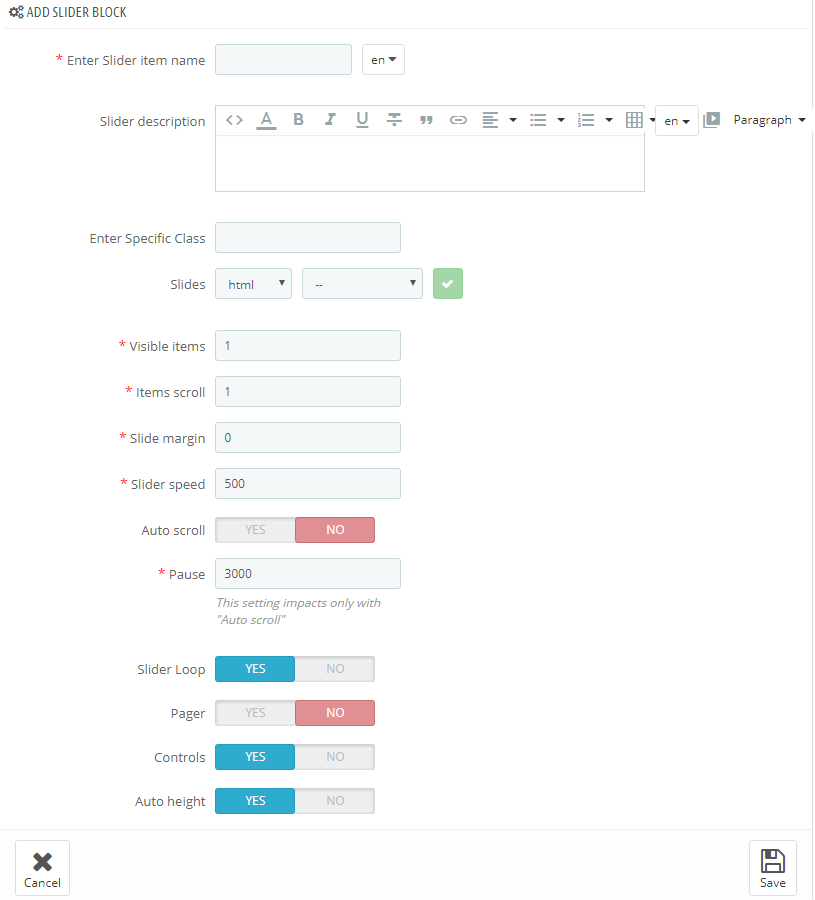
-
-
To delete Slider block, press 'Remove' (1) button. In order to edit block, press 'Edit'(2) button.

Export content
You may export all the extra content you've created to your computer as a zip file with one click only.
To download extra content, simply press "Export content"(1) tab. The downloading process will start automatically.

Import content
You can also import your own custom content from your computer, but zip files only!
To upload extra content, press "Import content" tab.

Press "Add file" (1) button and upload from your computer archive that contains extra content only.

Warnings
If the following message appears in the module item block, you should enable the mentioned module.

If the following message appears in the module item block, you should install the mentioned module.

In case you remove or deactivate the 'JX Mega Layout' module, all the active presets will be disabled and you will see the positions (hooks) in their original appearance.
JX Mega Menu
The module is designed to create complex menus. The module provides the ability to display one item (without sub-menu), a menu item with a sub-menu and a menu item with sub-menu by means of a multi-row and multi-column block. The module can be used in different positions, but it will display the same content. Available positions: top (displayTop), left (displayLeftColumn), right (displayRightColumn), footer (displayFooter). You can add categories (with subcategories), CMS categories (with subcategories), manufacturers (one or a list), suppliers (one or a list), stores (if multi-store is used), links to any product, information block about the product, custom links (not limited in quantity), custom HTML blocks (not limited in number) and banners. See below for more details.
The module includes 6 main tabs that allow customizing the menu.

JX Mega Menu Items
JX Mega Menu items are the basic items which appear in the menu.
In order to create a new item, open the JX Mega Menu module and click Add item button from the top menu or click "+" button in the top right of the table.

In the form that appears, fill in the required fields.
-
- Enter item name
- the tab title which is mandatory to be filled in for the default language, if the additional languages fields are not filled in, the tab takes its name from the default language.
-
- Active
- active/inactive tab.
-
- Link
- a link that is assigned to this tab. You can enter a custom link, or choose from existing options (categories, CMS categories). If you leave the field blank, the link of this tab is inactive.
-
- Sort order
- the order of tabs to be displayed.
-
- Specific Class
- the class which is added to emphasize the item (CSS class).
-
- Enter item badge
- is filled in depending on multi-languages.
-
- It is Mega Menu
- given tab sub-menu is a Mega Menu. *
-
- Use simple menu
- given tab sub-menu is a simple menu. **
* It is Mega Menu. If this option is selected, there will be a form to create a complex menu (Mega Menu).
** Use simple menu. If this option is selected, there will be a form to create a simple menu. This is a menu that displays the selected content in a single column. If the menu has embedded content, the new column is added.
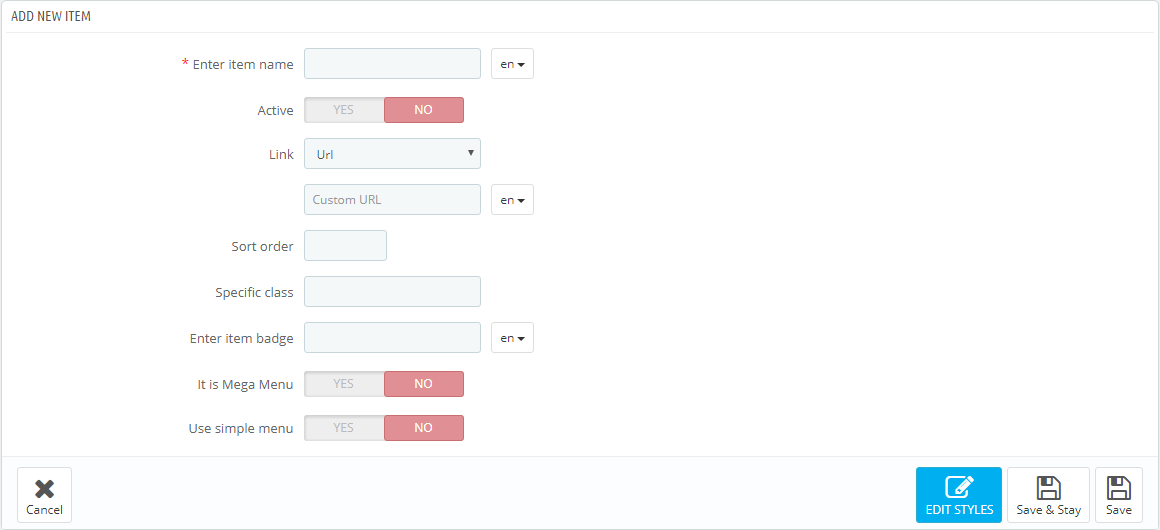
Complex menu consists of rows and columns in rows.
The Row is a part of the Mega Menu structure. It includes the menu columns. The existing row can be removed by clicking the appropriate button. The row will be removed with the content it includes. The rows quantity is not limited.
The Column is a part of the Mega Menu structure, which is placed inside the rows. (The Class) The width of the column cannot be less than 2 and more than 12. In order to make the menu display properly, the total column width cannot exceed 12. The width (class) is a Bootstrap column type, corresponds to the same values.
In order to create the menu, click the 'Add row' button.
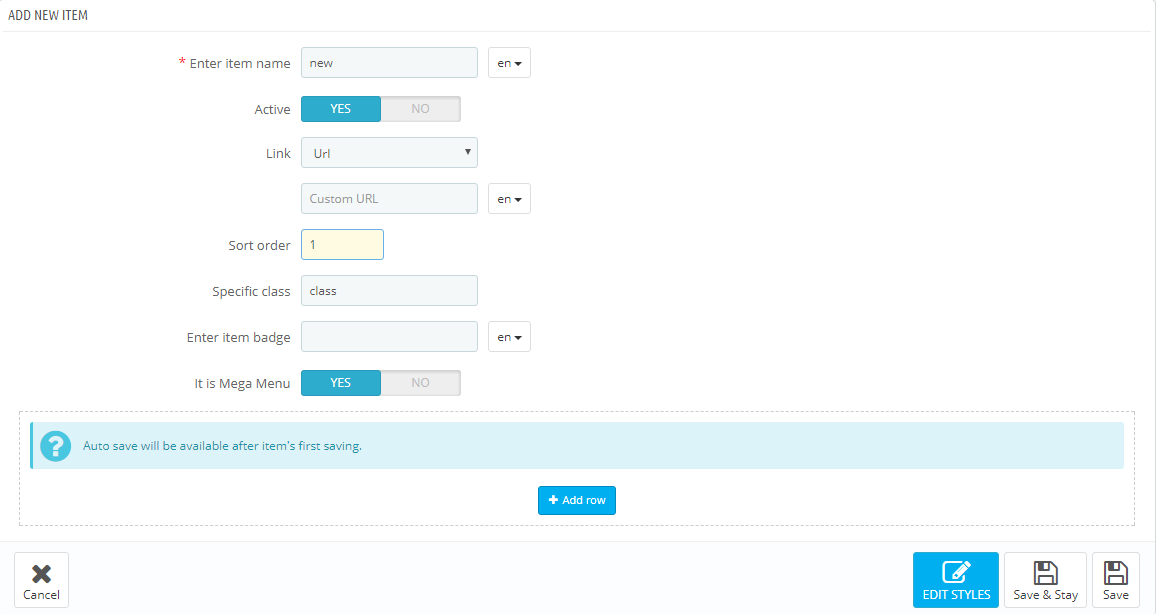
In the form appeared, click 'Add column' button.

In the pop up window you need to specify the column class (from 2 to 12). The column itself appears next where you need to set the required settings.
Here you can change the column class, CSS class and the content from the list provided. You can add/remove content by double clicking the item, or by highlighting the items and clicking the corresponding button.
Block can be removed by clicking 'Remove block' button in the footer of the block.
By removing the row, the included columns are also removed.

In order to move the content available in the selected menu, double-click or highlight the desired content and press the corresponding button.
Inactive menu information is saved while switching between menu types and you can always change the type of menu.
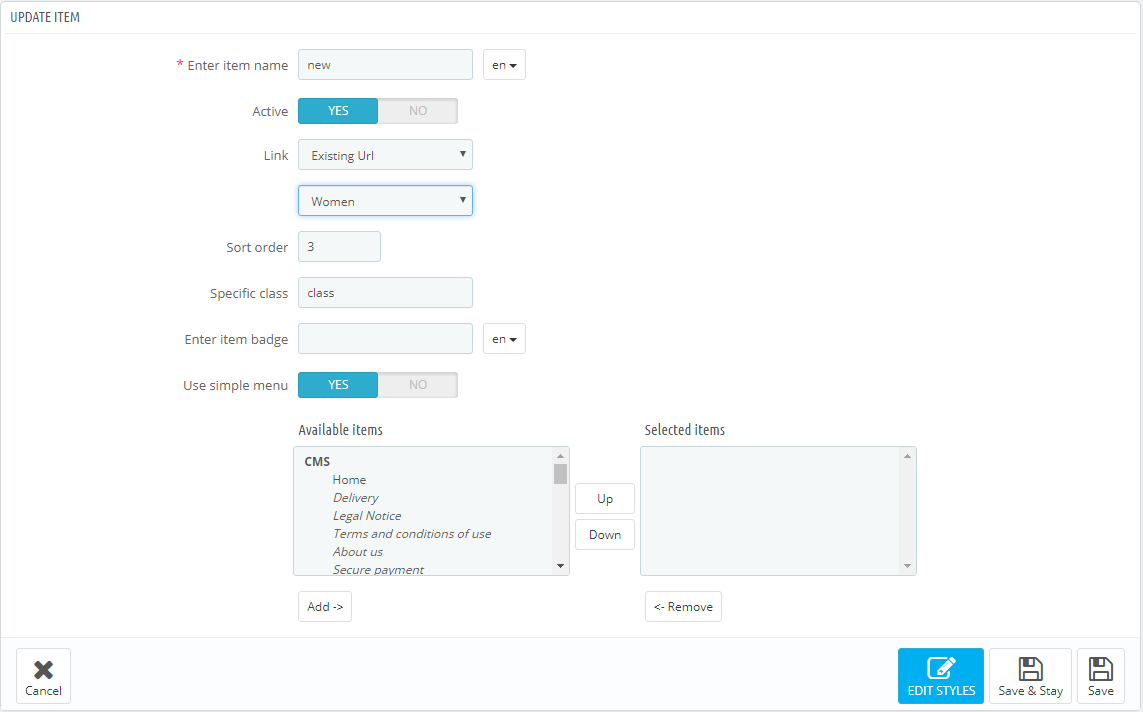
JX Mega Menu HTML
In this section we will explain how to create a custom HTML block in the Mega Menu.
The module has a table listing all the available blocks. You can also add a new block by clicking the '+' button in the top right of the table.
In the form that appears, fill in the required fields.
-
- Enter HTML item name
- HTML block name, is mandatory to be filled in for the default language.
-
- Specific class
- block's CSS class.
-
- HTML content
- HTML content.
Added block will appear in the list of blocks, as well as in the list of available content while creating menu blocks.

JX Mega Menu Links
In this section we will show how to create custom links in the Mega Menu.
The module has a table listing all the available links. You can also add a new link by clicking the '+' button in the top right of the table.
In the form that appears, fill in the required fields.
-
- Enter Link name
- link name, is mandatory to be filled in for the default language.
-
- Enter Link URL
- link URL, is mandatory to be filled in for the default language.
-
- Specific class
- block's CSS class.
-
- Open in new window
- open link in a new window.
Added link will appear in the list of links, as well as in the list of available content while creating menu blocks.

JX Mega Menu Banners
In this section we will explain how to create banners in the Mega Menu.
The module has a table listing all the available banners. You can also add a new banner by clicking the '+' button in the top right of the table.
In the form that appears, fill in the required fields.
-
- Select a file
- select a file, is mandatory to be filled in for the default language.
-
- Enter Banner name
- banner title, is mandatory to be filled in for the default language.
-
- Enter Banner URL
- link URL, is mandatory to be filled in for the default language.
-
- Specific class
- block's CSS class.
-
- Public Title
- public banner title.
-
- Description
- set the description of the banner.
-
- Open in new window
- open link in a new window.
Added banner will appear in the list of banners, as well as in the list of available content while creating menu blocks.

JX Mega Menu Video
In this section we will explain how to add a video in the Mega Menu.
The module has a table listing all the available videos. You can also add a new video by clicking the '+' button in the top right of the table.
In the form that appears, fill in the required fields.
-
- Enter Video Name
- video title (the field is required).
- Enter Video URL - add video link in the formats described below:
- If this is a YouTube video, click on Embed and copy the code between the quotes for https://www.youtube.com/embed/video_id
- If this is a Vimeo video, click on Share icon and in the Embed section copy the source code between the quotes for http://player.vimeo.com/video/video_id
Added video will appear in the list of videos, as well as in the list of available content while creating menu blocks.

JX Mega Menu Map
In this section we will explain how to add a map in the Mega Menu.
The module has a table listing all the available maps. You can also add a new map by clicking the '+' button in the top right of the table.
In the form that appears, fill in the required fields.
-
- Enter Map item name
- the title of the map.
-
- Enter Map latitude
- set a latitude value.
-
- Enter Map longitude
- set a longitude value.
-
- Marker
- adding a custom marker.
-
- Enter Map scale
- the scale of the map (used 8 by default).
-
- Map description
- set the description of the map.
Added map will appear in the list of maps, as well as in the list of available content while creating menu blocks.
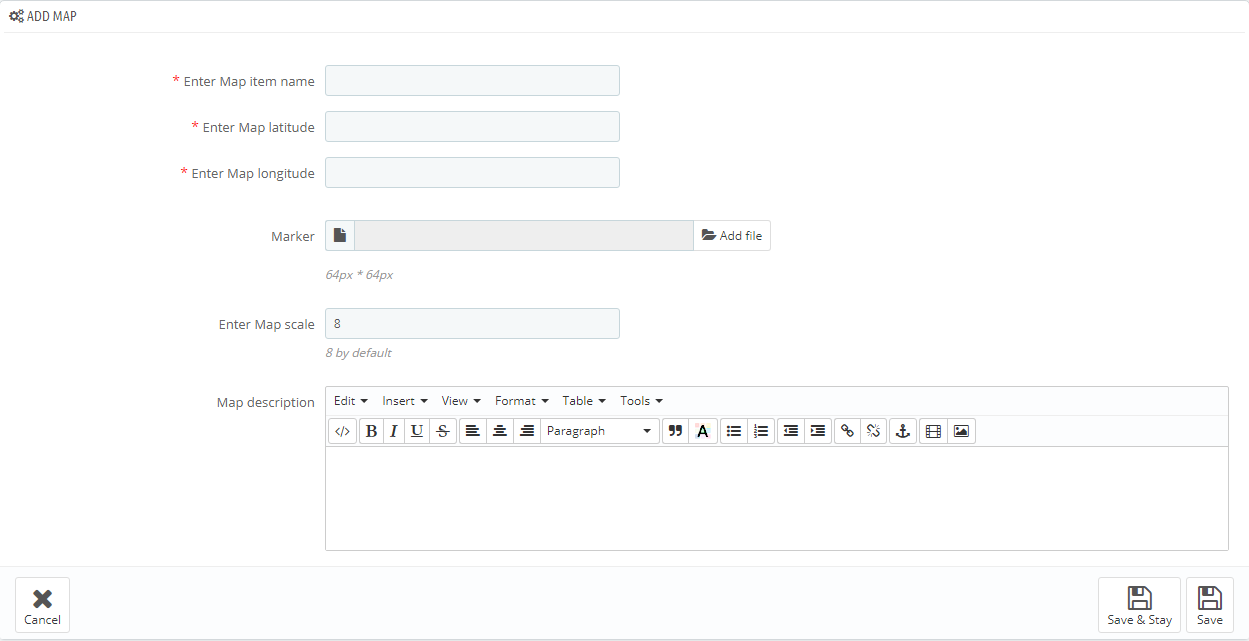
JX Product List Gallery 2.0.0
This module displays all the available product images in form of a gallery on product listing pages. Depending on what settings you choose, the module can display images in form of a rollover or slideshow.
Module Installation and Deleting
This module can be installed and deleted like any other PrestaShop module.
Module settings
After the module is installed, navigate to \themes\classic\templates\catalog\_partials\miniatures\product.tpl. Open this
file and find the following code:
{block name='product_thumbnail'}
{if $product.cover}
<a href="{$product.url}" class="thumbnail product-thumbnail">
<img src="{$product.cover.bySize.home_default.url}" alt="{if !empty($product.cover.legend)}{$product.cover.legend}{else}{$product.name|truncate:30:'...'}{/if}" data-full-size-image-url="{$product.cover.large.url}">
</a>
{else}
<a href="{$product.url}" class="thumbnail product-thumbnail">
<img src="{$urls.no_picture_image.bySize.home_default.url}">
</a>
{/if}
{/block}
and replace it with:
{block name='product_thumbnail'}
{if $product.cover}
<a href="{$product.url}" class="thumbnail product-thumbnail">
{capture name='displayProductListGallery'}{hook h='displayProductListGallery' product=$product}{/capture}
{if $smarty.capture.displayProductListGallery && count($product.images) > 1}
{hook h='displayProductListGallery' product=$product}
{else}
<img src="{$product.cover.bySize.home_default.url}" alt="{if !empty($product.cover.legend)}{$product.cover.legend}{else}{$product.name|truncate:30:'...'}{/if}" data-full-size-image-url="{$product.cover.large.url}">
{/if}
</a>
{else}
<a href="{$product.url}" class="thumbnail product-thumbnail">
<img src="{$urls.no_picture_image.bySize.home_default.url}">
</a>
{/if}
{/block}
After installing and connecting the module, you can set it up on the module configuration page.
The module has the following main settings:
- Live mode - ability to use the module in live mode.
- Type - select display type: rollover, gallery or slideshow.
If you choose rollover, you can choose the animation effect:
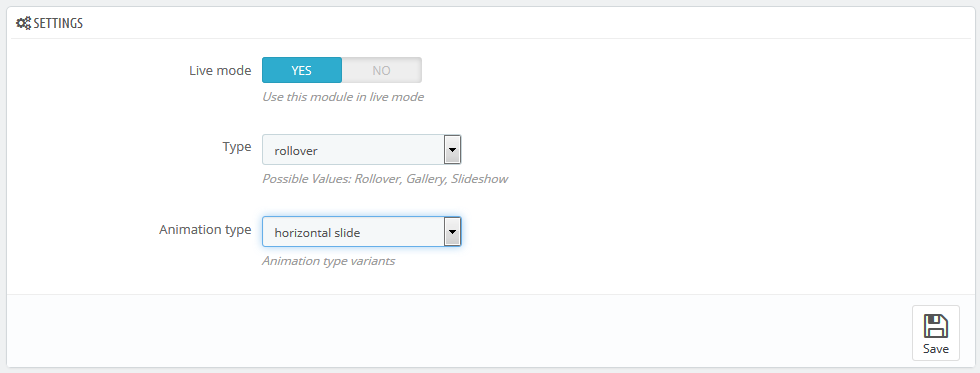
- Opacity slide - opacity changes;
- Horizontal slide - horizontal;
- Vertical slide - vertical.
If you choose gallery, you will find the following settings available:

- Display items - the number of items displayed;
- Visible items in row - the number of items in a row;
- Use carousel - enable/disable the carousel for this block.
If you choose slideshow, you will find the following settings available:
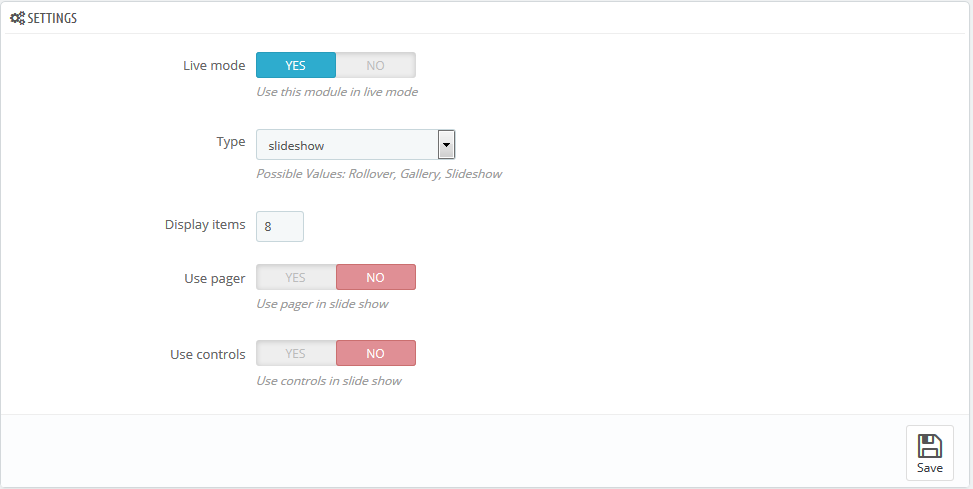
- Display items - the number of items displayed;
- Use pager - pager display in slide show;
- Use controls - controls display in slide show.
JX Product Zoomer
This module is an alternative solution for the standard product image zoom on the single product page. It's fully compatible with the standard additional products thumbnail carousel and product attributes changes. It allows you to choose among the three available options (window/lens/inner) for image zoom with the advanced plugin settings. The module is based on the Elevatezoom Plus plugin.
Installation and removing
The module is installed and deleted like any other PrestaShop module.
Module configuration
After the module has been installed you can configure it on the module configuration page.
By default, the configuration page shows a simplified set of options.
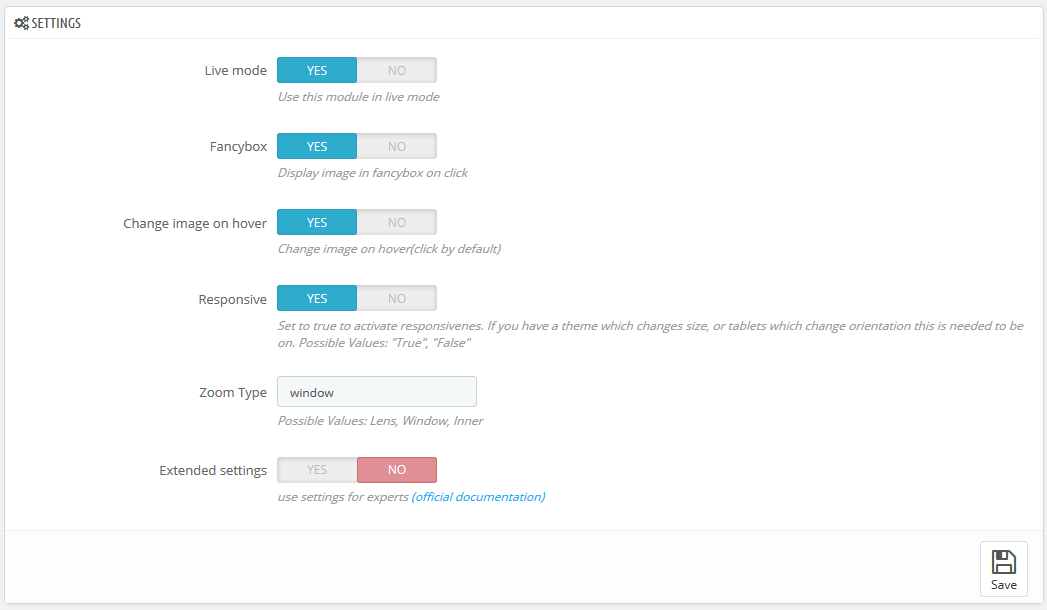
- Live mode - module is on/off.
- Fancybox - whether to show the enlarged image in the Fancybox on click.
- Change image on hover - switch the main image on thumbnail hover (by default is set to switch on click).
- Responsive - allows to the use adaptive functionality for plugin display on the mobile devices.
- Zoom Type - choose the type of the enlarged image display mode
- window - the enlarged image shows up next to the main image in one of the available (16) positions
- lens - the image is zoomed in the lens container, on top of it
- inner - the image is zoomed inside of main image container, fully covering it.
The mobile devices (< 768) have "lens" mode activated instantly. - Extended settings - enables advanced settings for the experienced users. You can see the link to the official documentation for more details next to it.
Extended module configuration
- Scroll Zoom - zoom ratio change on the mousewheel scroll (available for all types).
- Cursor - cursor type on the magnified image hover. The following options are available: default, cursor, crosshair (available for all types).
- Zoom settings - available for all types, if the 'Scroll Zoom' is enabled.

- Zoom Level - the zoom level on the initial hover.
- Min Zoom Level - a minimum zoom level.
- Max Zoom Level - a maximum zoom level.
- Scroll Zoom Increment - magnifying scroll increment.
- Easing - the magnified image appearance effect (available for all types).

- Zoom Easing - effect on/off.
- Easing Amount - effect delay value.
- Image Crossfade - main image blur outside the hover area (the lens) - available for window, lens.
- Magnified image window settings - available for window.

- Zoom Window Width - window width in px.
- Zoom Window Height - window height in px.
- Zoom Window Offset X - window offset on the X axis.
- Zoom Window Offset Y - window offset on the Y axis.
- Zoom Window Position - window position choice relatively to the main image (the positions available are presented on the image below this field).
- Zoom Window Bg Color - window background image (for transparent images only).
- Zoom Window Fade In - the effect of slowing the window appearance.
- Zoom Window Fade Out - the effect of slowing the window disappearance.
- Border Size - window border width in px.
- Border Color - window border color.
- Zoom Lens - zoom lens (available for window, lens).

- Zoom Lens - on/off.
- Lens Shape - lens type. It can take the following values: circular/rounded or squared/rectangular.
- Lens Color - lens inner background color.
- Lens Opacity - lens inner background opacity.
- Lens Size - lens size in px.
- Lens Fade In - the speed of lens appearance effect.
- Lens Fade Out - the speed of lens disappearance effect.
- Lens Border - lens border width.
- Lens Border Color - lens border color.
- Contain Lens Zoom - the restriction of the lens overflow outwards the main image container.
- Tint - the shade effect on the area outside the lens (available for window).
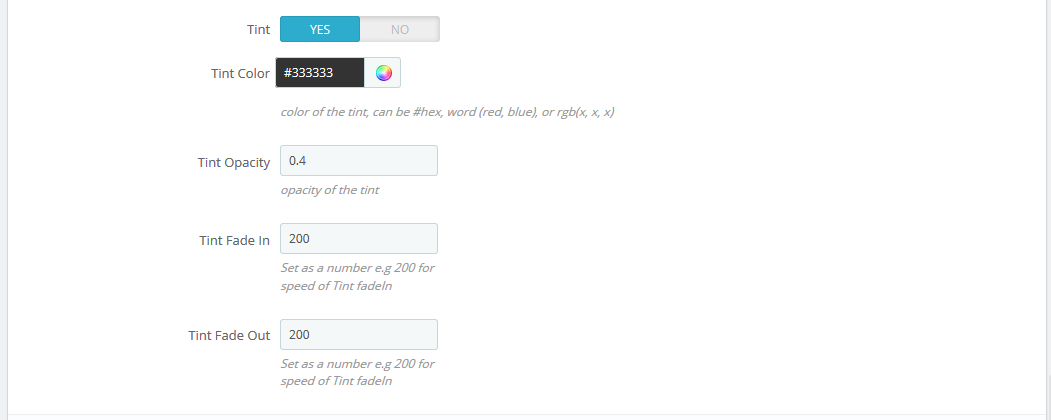
- Tint - effect on/off.
- Tint Color - the lens outer area background.
- Tint Opacity - the lens outer area opacity.
- Tint Fade In - the appearance effect speed.
- Tint Fade Out - the disappearance effect speed.
